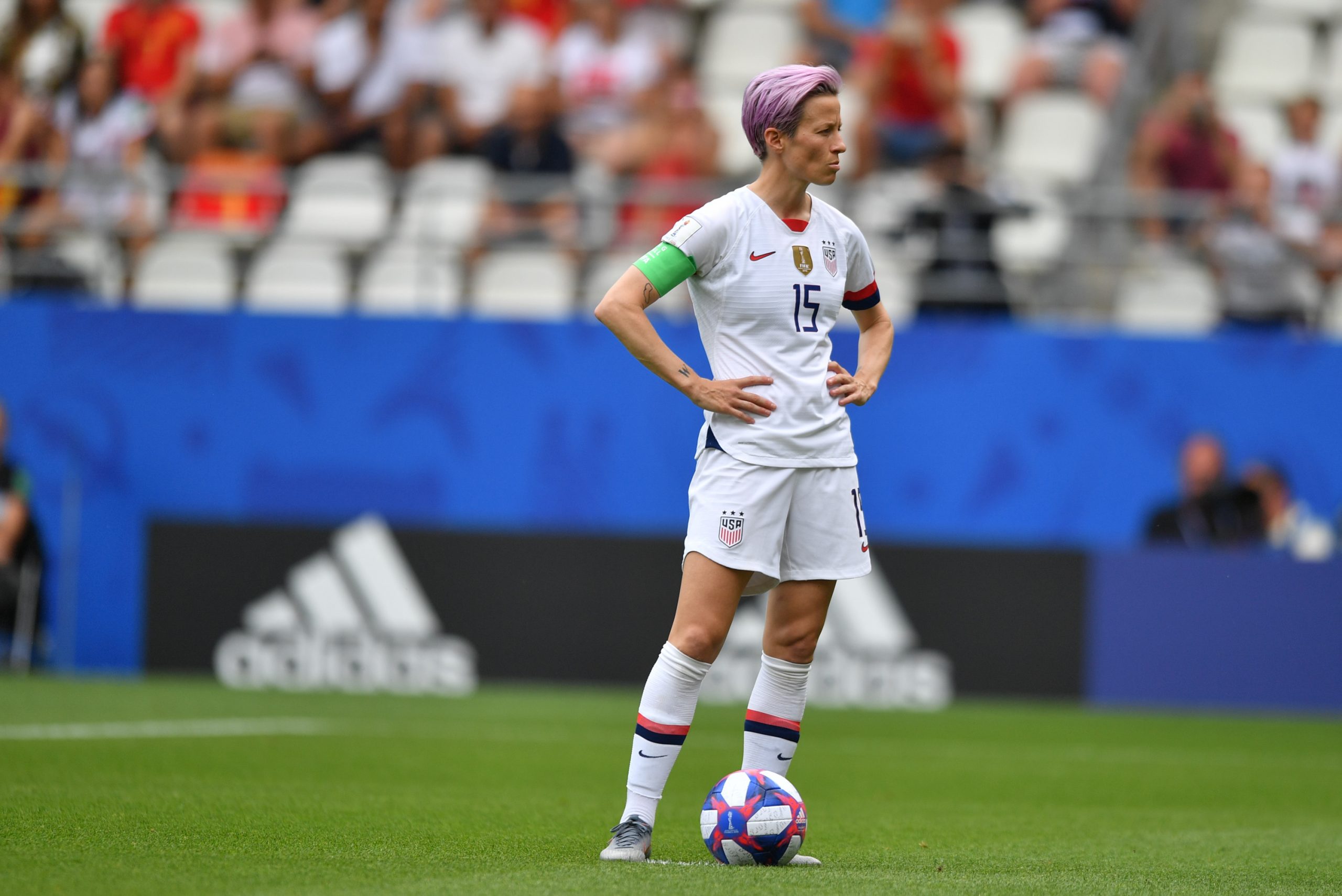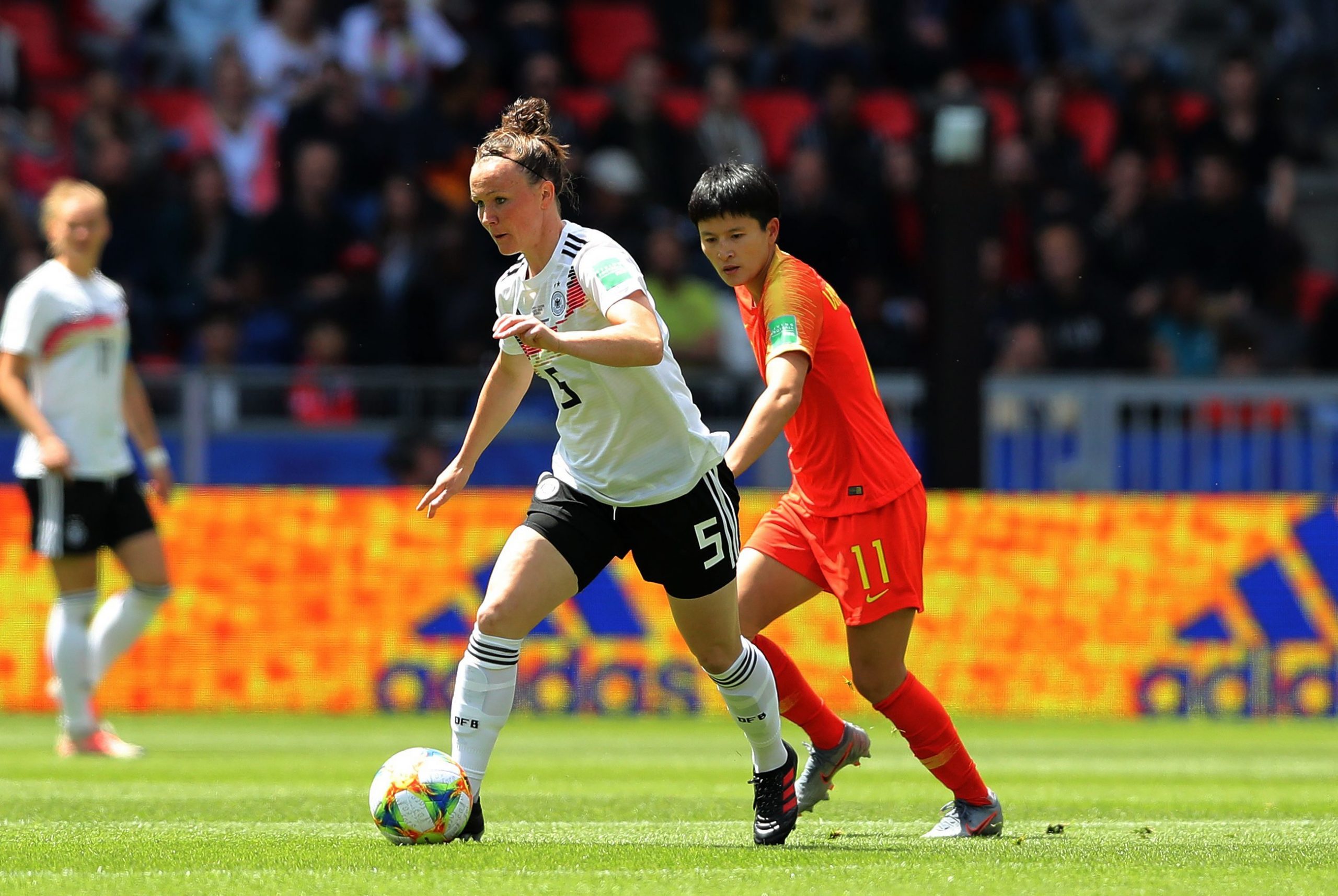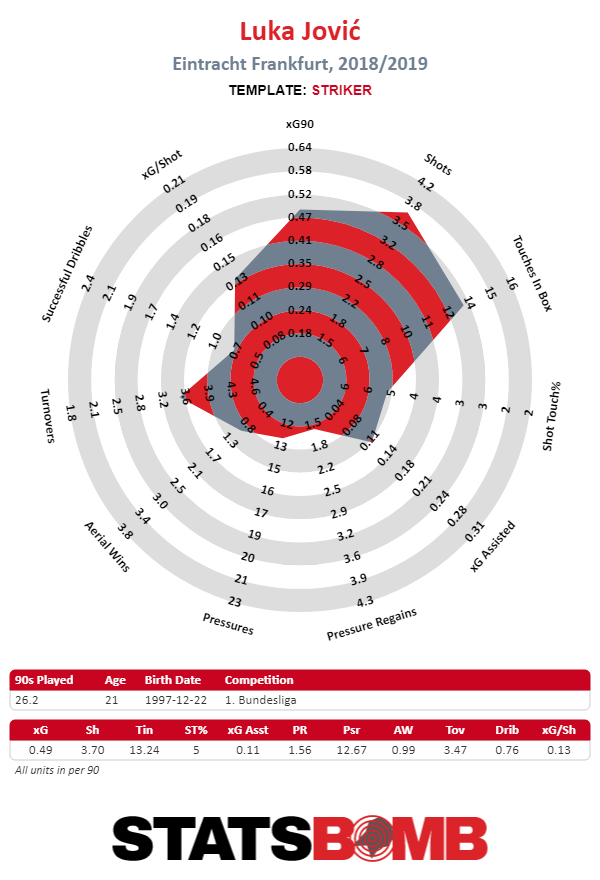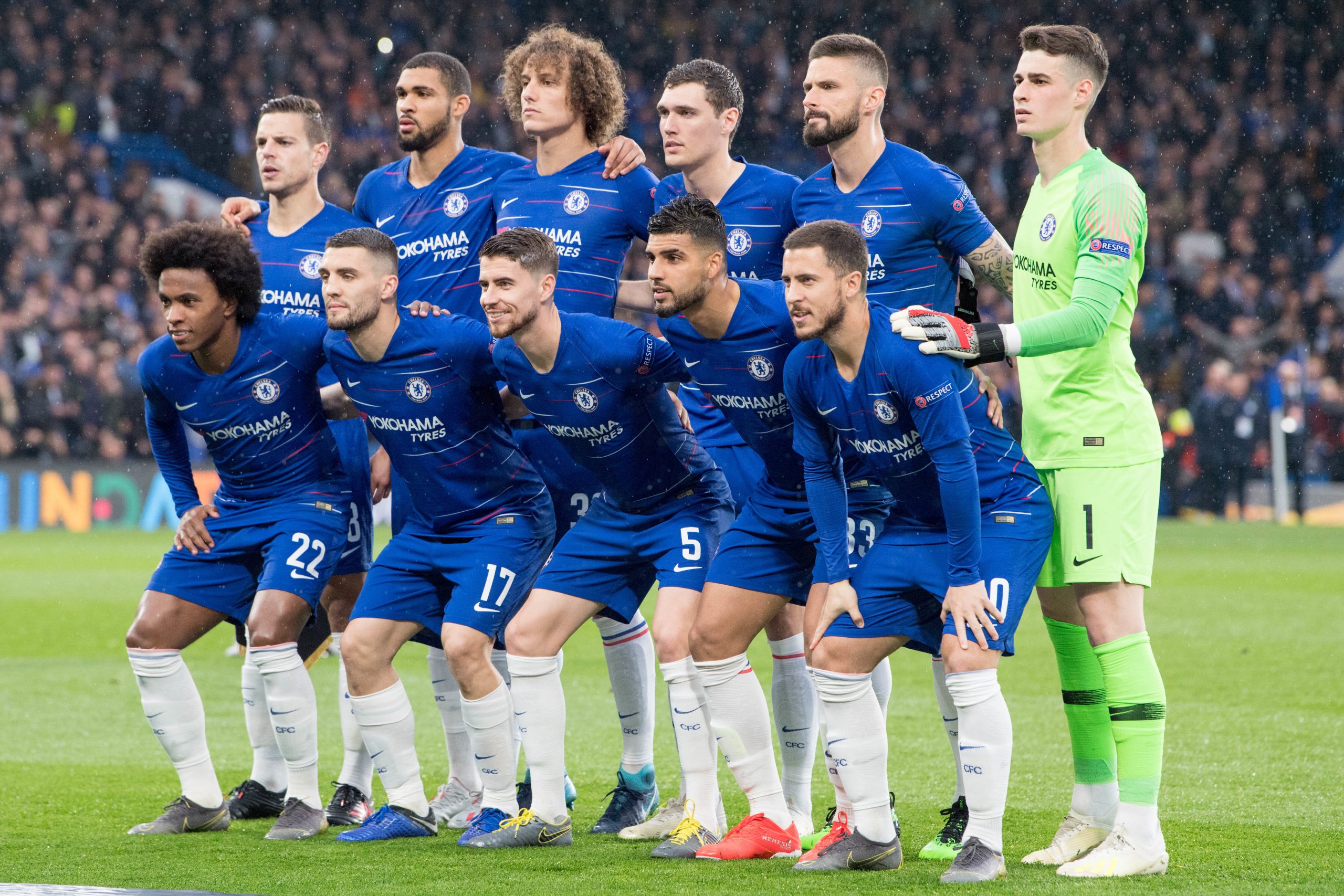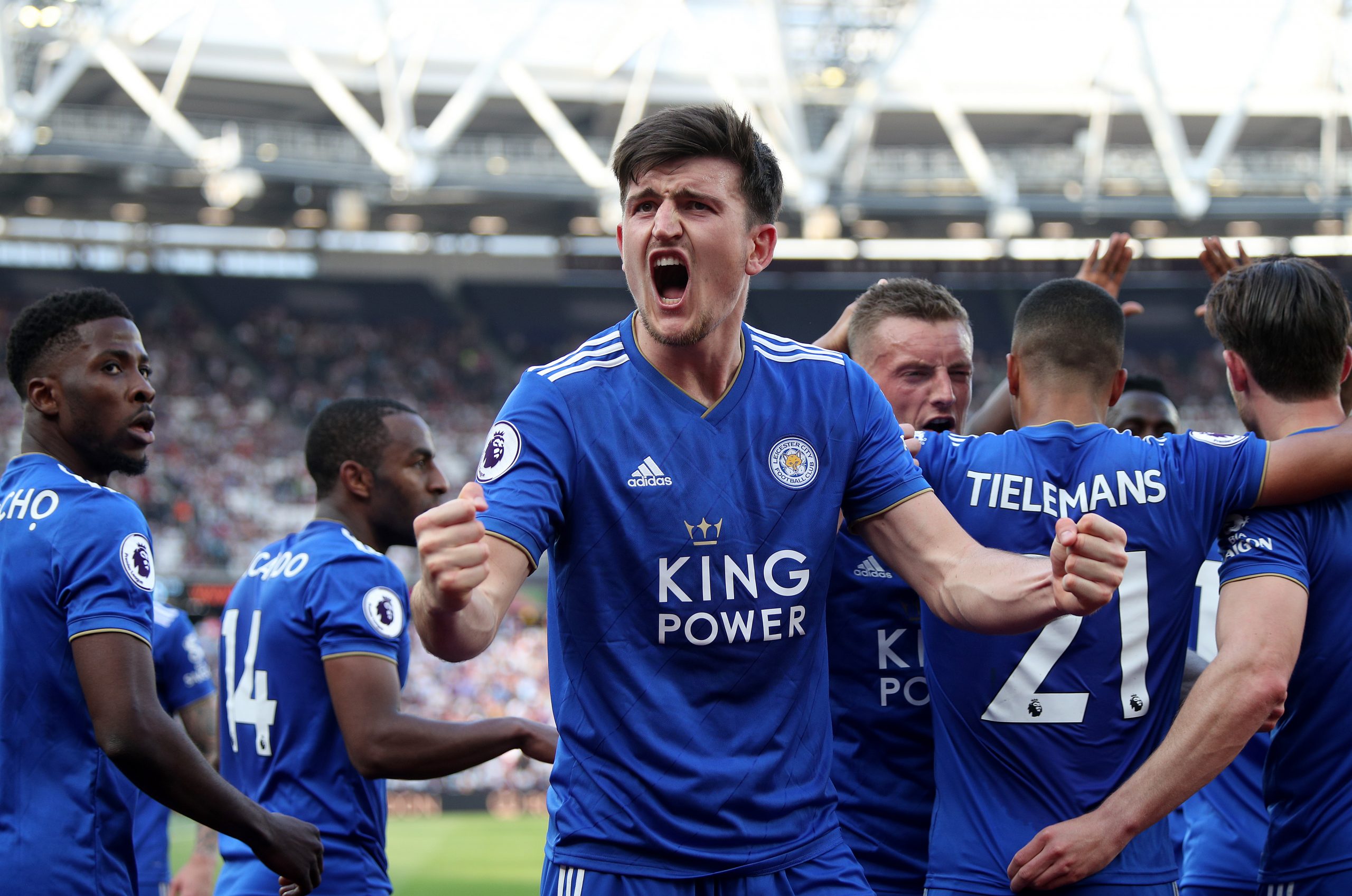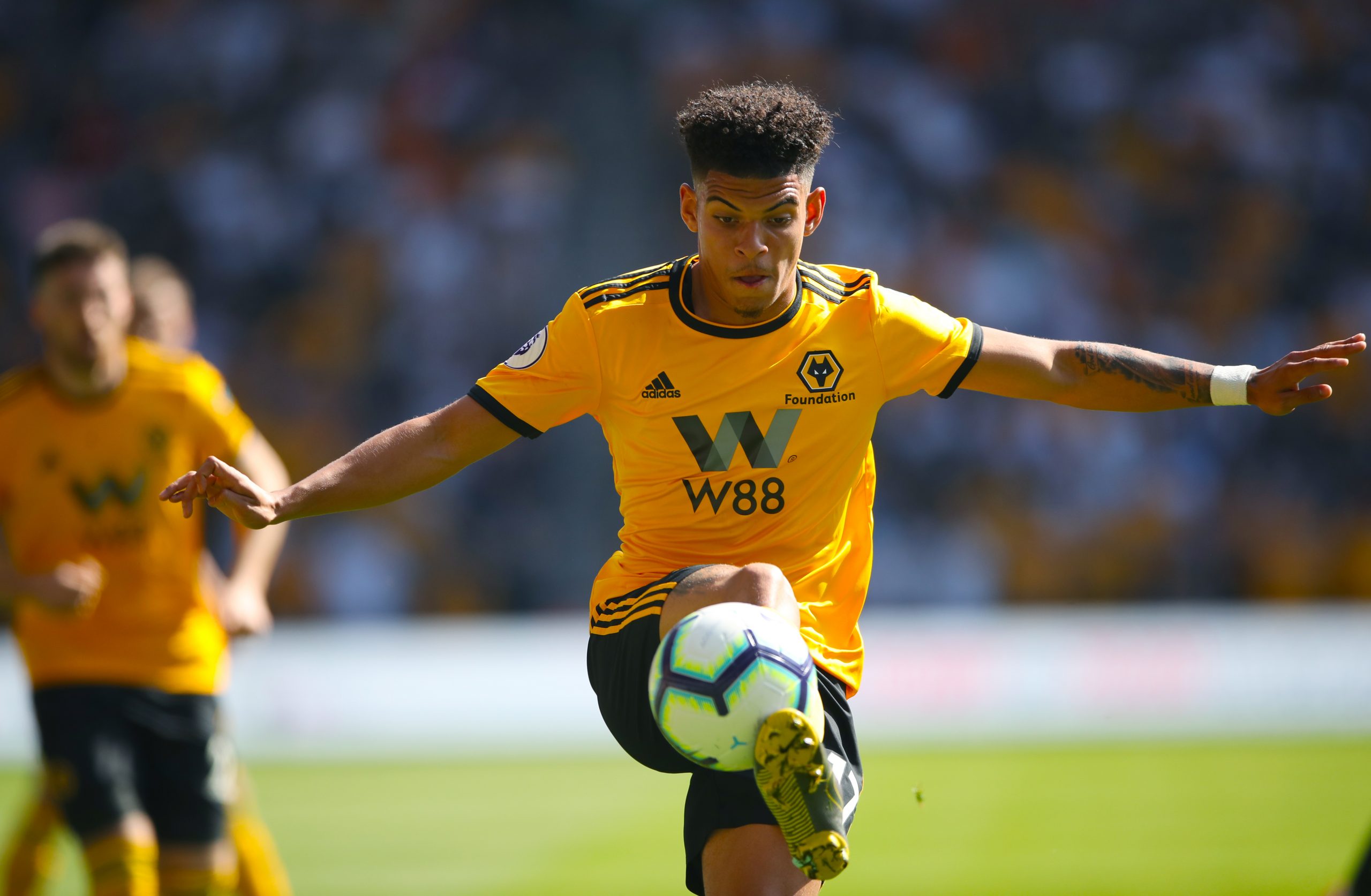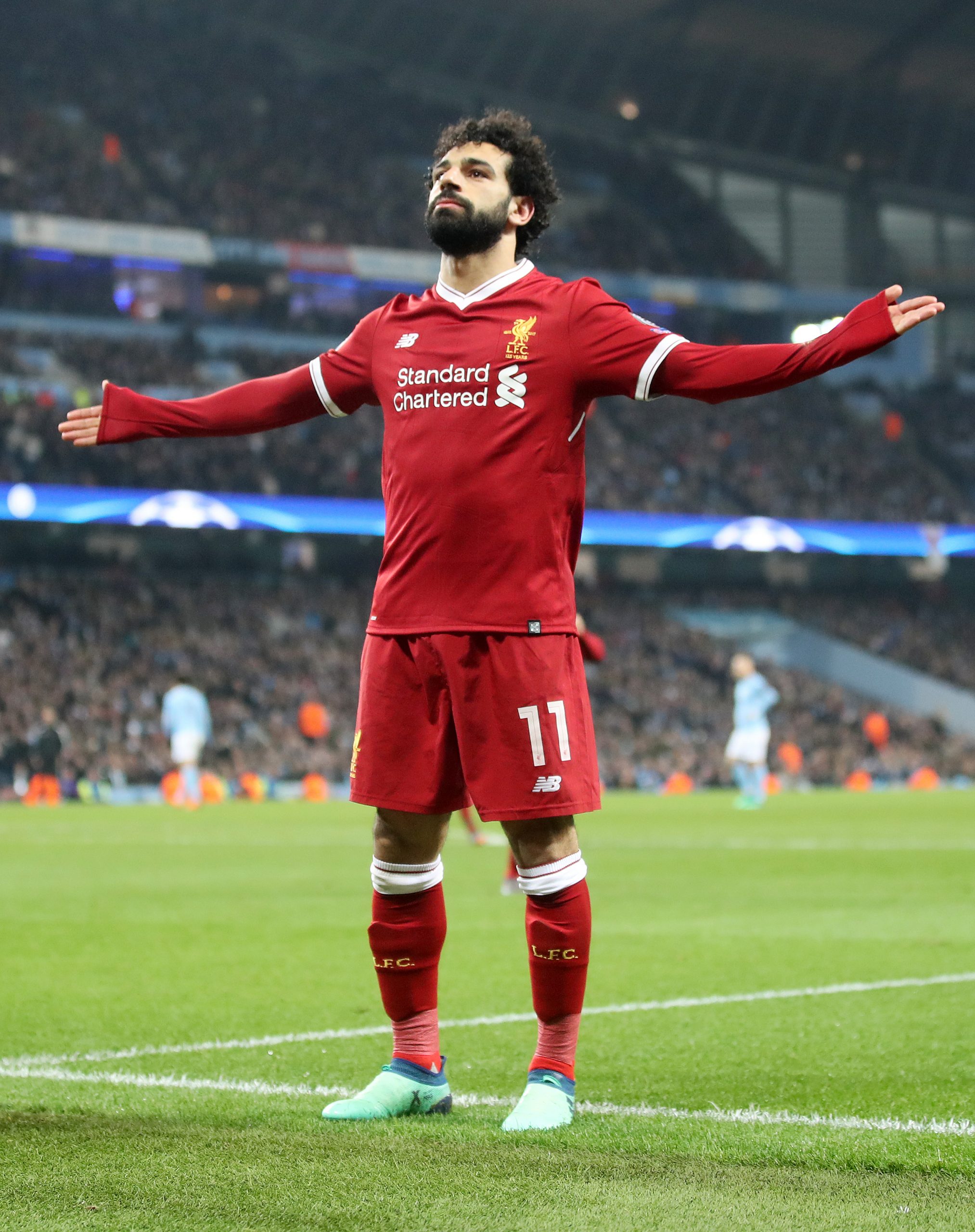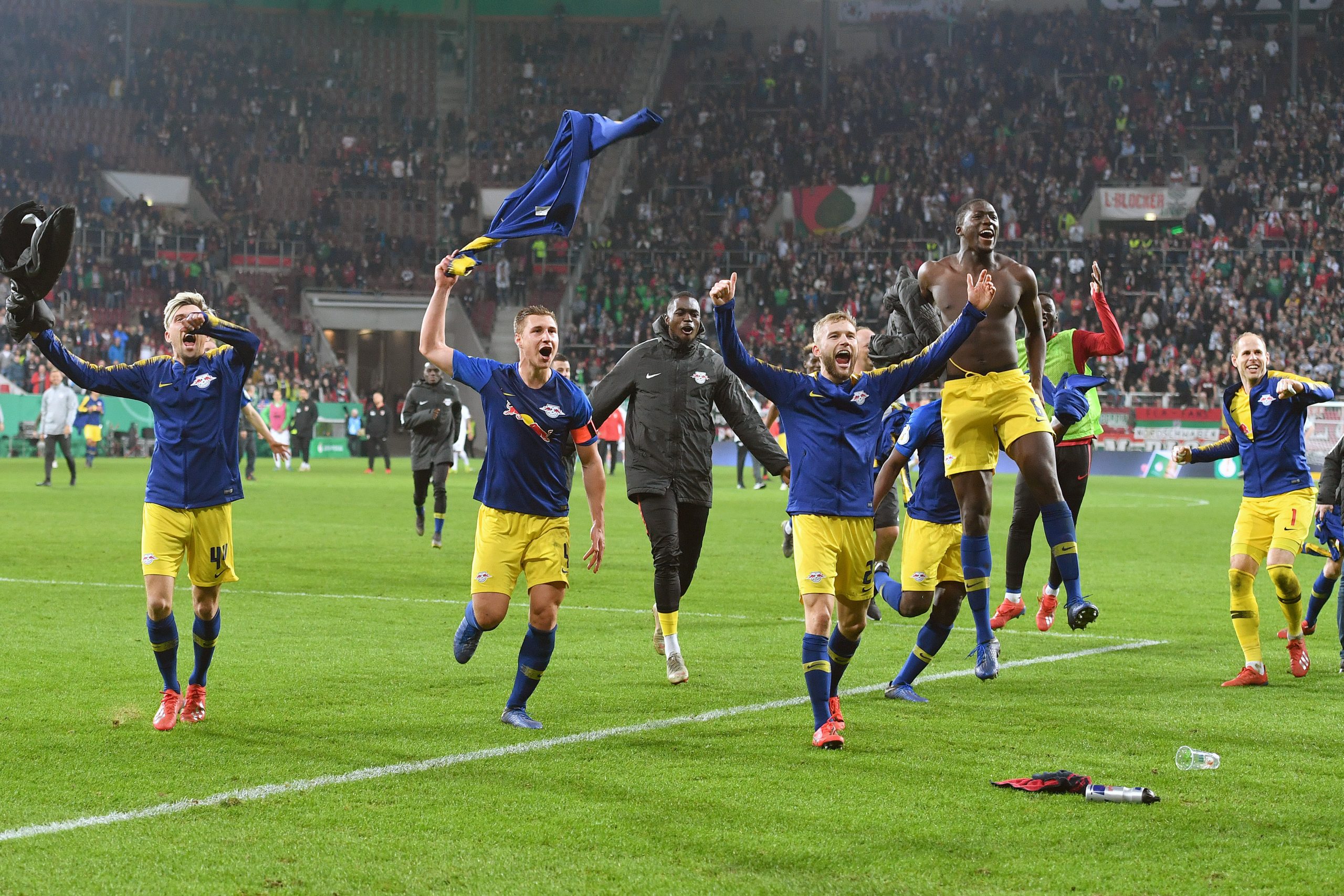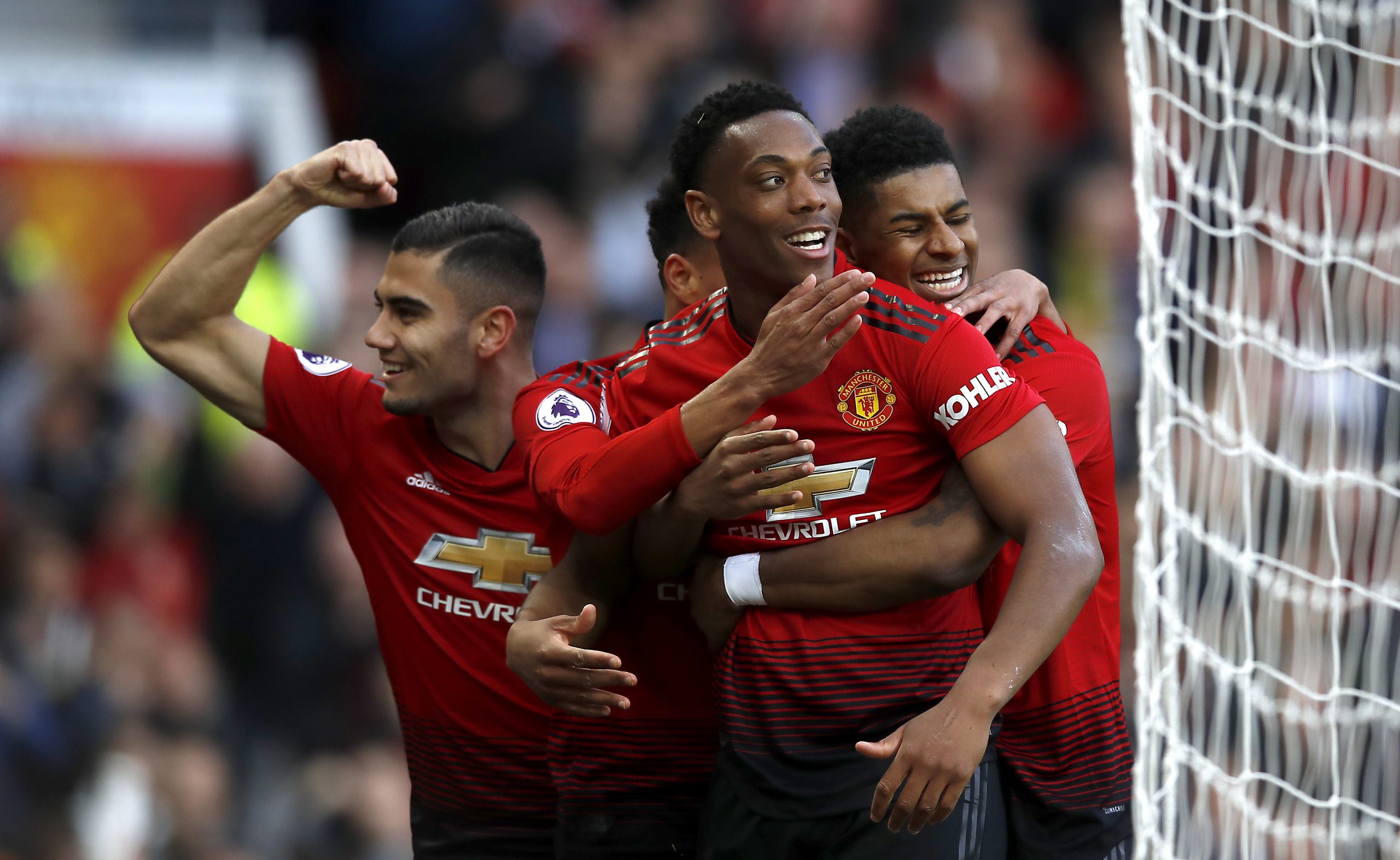The two World Cup favorites are through to the quarterfinals. France and the United States are set to square-off in the match of the tournament, in a game that many expect will determine the ultimate World Cup winner. But both struggled to get there, being tested, respectively, by Brazil and Spain. And, surprisingly, rather than their weaknesses being exposed, it was the areas where both teams were thought to be strongest, where cracks emerged. The conventional wisdom about the United States is that while their attack might be high powered, defensively they can, at times, be shaky. That certainly seemed to be the case when, after taking the lead thanks to a sixth minute penalty, a horrible mix-up at the back between Becky Sauerbrunn and Alyssa Naeher led to a gift of an equalizer. But, from that moment on, despite sometimes seeming dangerous, Spain actually generated very little in attack. The underdogs took a grand total of four shots, and none from closer than the edge of the penalty area. 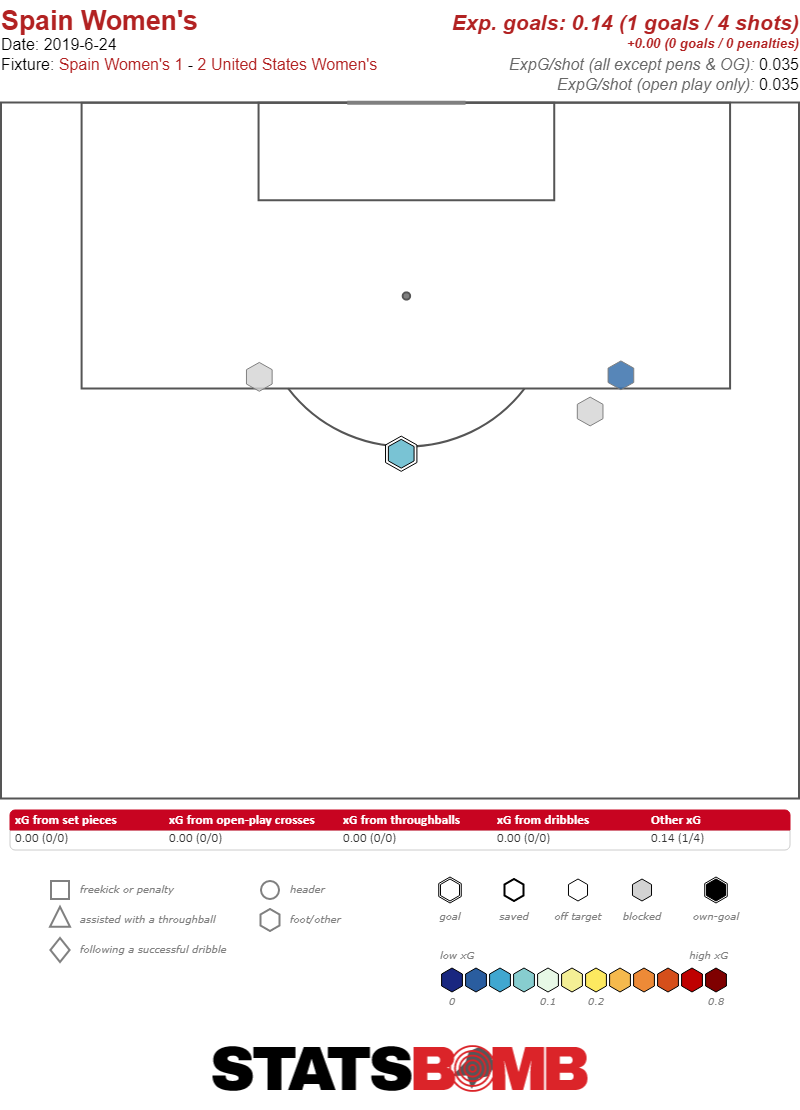 What Spain did do is cross the ball a lot. They targeted Crystal Dunn on the left side of the American defense, and worked the ball down the flank to Lucía García, who then was asked to supply service into the box. But that service never amounted to anything.
What Spain did do is cross the ball a lot. They targeted Crystal Dunn on the left side of the American defense, and worked the ball down the flank to Lucía García, who then was asked to supply service into the box. But that service never amounted to anything. 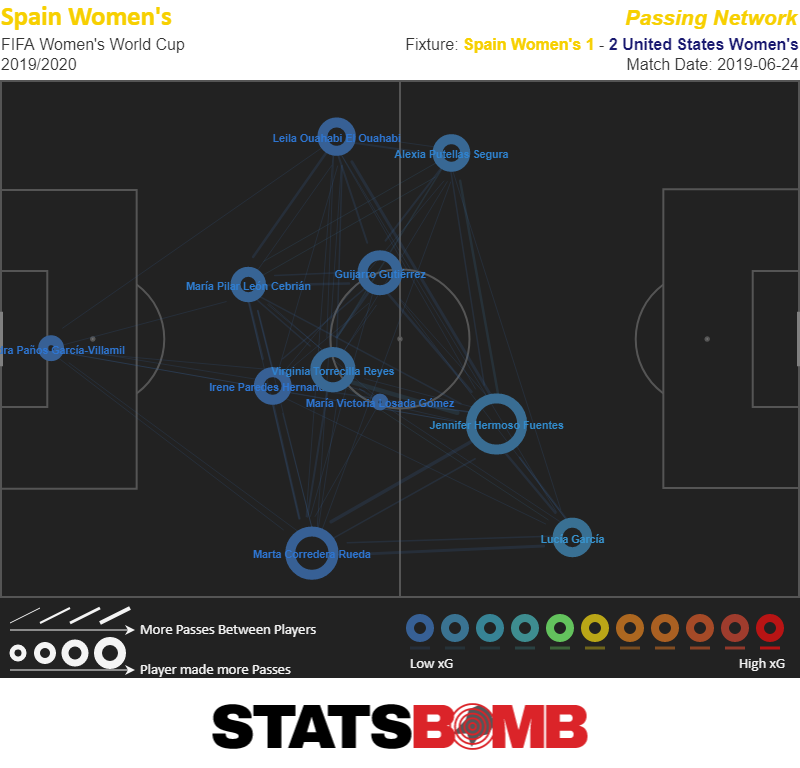 Although Dunne was unable to prevent service from coming in, the rest of the defensive line was consistently well positioned to deal with the never ending stream of crosses, and despite her reputation for shakiness, Naeher put in a strong, aggressive performance commanding her box. She claimed six of the 41 balls that were theoretically within her range, when on average a keeper might have been expected to claim only four.
Although Dunne was unable to prevent service from coming in, the rest of the defensive line was consistently well positioned to deal with the never ending stream of crosses, and despite her reputation for shakiness, Naeher put in a strong, aggressive performance commanding her box. She claimed six of the 41 balls that were theoretically within her range, when on average a keeper might have been expected to claim only four. 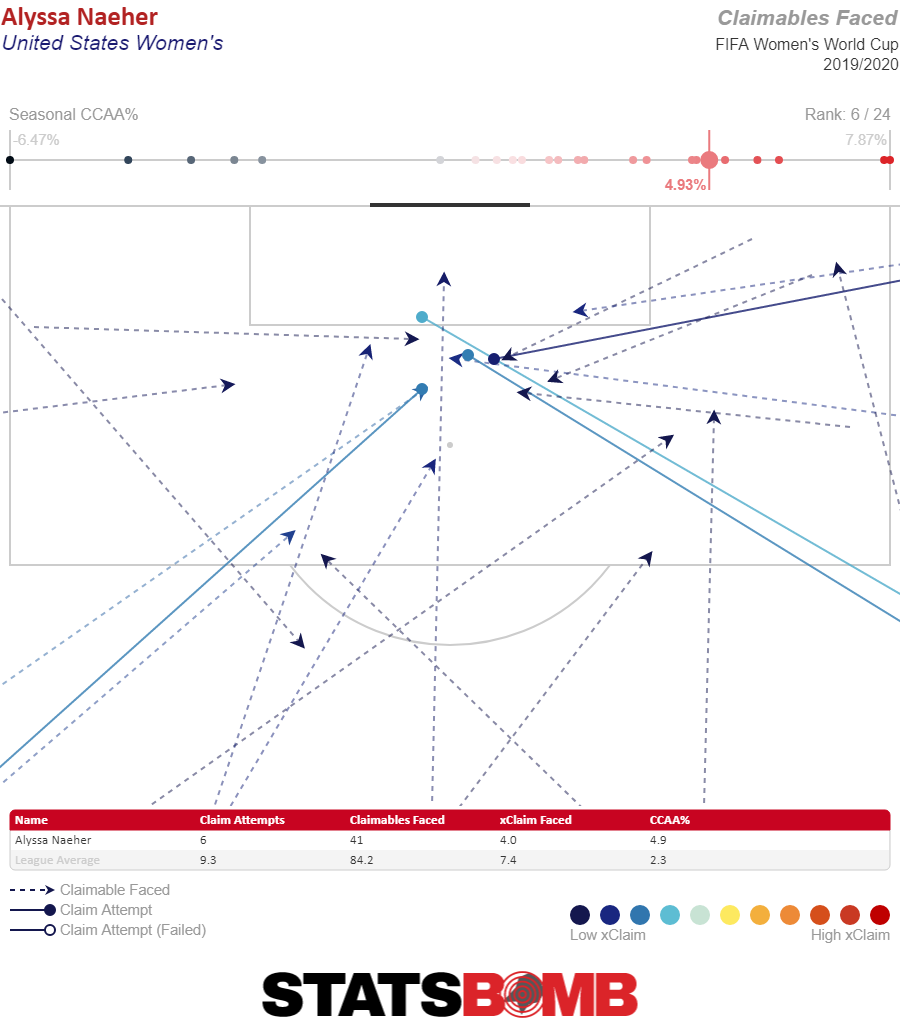 Spain didn’t ask difficult questions of the American defense, and the easy ones, which they asked quite frequently, were answered with ease. The problem is that the vaunted American attack didn’t live up to their reputation. Outside of the two penalties they were awarded, the favorites took nine shots which amounted to only 0.88 expected goals
Spain didn’t ask difficult questions of the American defense, and the easy ones, which they asked quite frequently, were answered with ease. The problem is that the vaunted American attack didn’t live up to their reputation. Outside of the two penalties they were awarded, the favorites took nine shots which amounted to only 0.88 expected goals 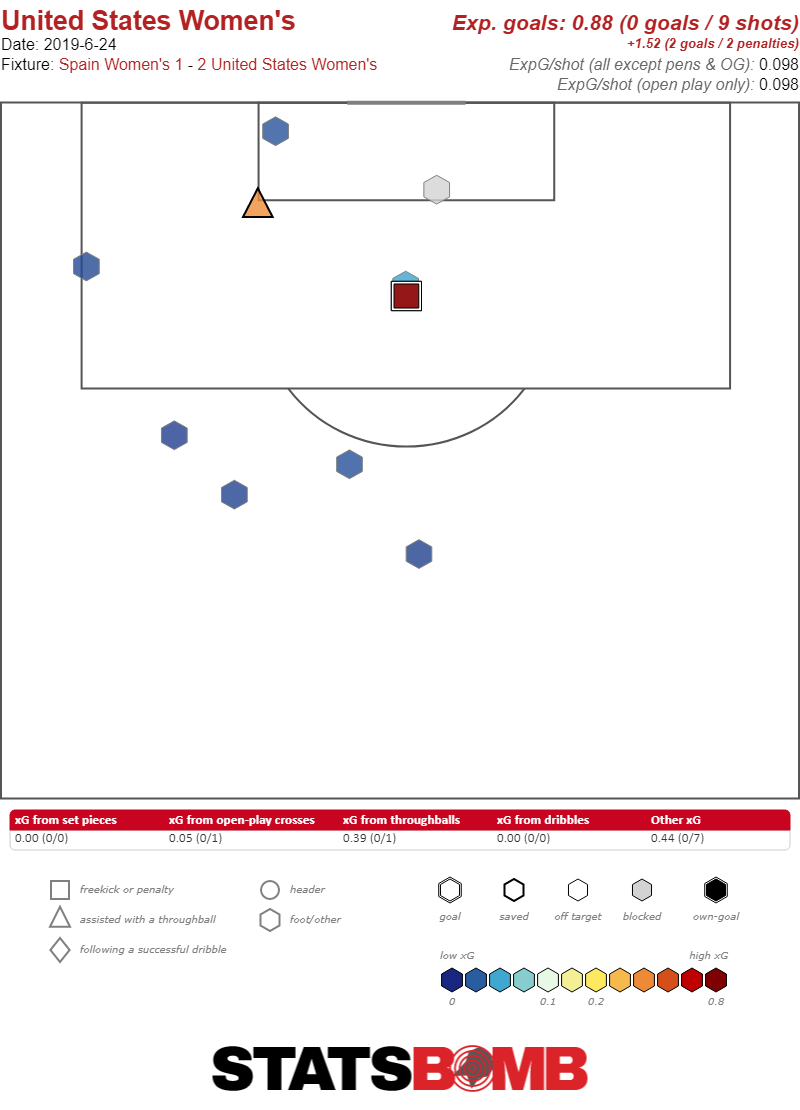 This might be excusable if the side was protecting a lead for most of the match, but they were not. There were two minutes between when the team scored the opening penalty, and Spain’s equalizer, and then it wasn’t until the 75th minute when the second penalty was awarded. And after the 16th minute the U.S. didn’t have a single shot from open play valued at over 0.05 xG. There are reasons for that. Lindsey Horan, who might be the best all-around midfielder in the world, was held in reserve, possibly because she was carrying a yellow card. Alex Morgan, the team’s iconic center forward had a poor game, spent a lot of time picking herself up off the ground after being kicked, and is possibly carrying an injury (she was subbed off at halftime of the team’s third group stage game against Sweden). Sometimes a team just doesn’t play well. Still, the main takeaway from Spain’s surprisingly game performance is not that the U.S. is vulnerable defensively, although it’s possible to see how a better team might have turned their copious crossing opportunities into more dangerous goal scoring chances, but rather that sometimes that vaunted attack can, in fact, be slowed down. The opposite is true of France. France’s attack has been somewhat underwhelming all tournament. The side has largely relied on the impeccable set piece skills of Wendie Renaud, and doing just enough to put opponents away before playing incredibly stingy defense. That’s what made the fact that they conceded 12 shots to Brazil so surprising (even accounting for extra time). This was a side that gave up 12 shots total in the group stage. And it’s not like the group stage was a walkover. They held Norway, a fellow quarterfinalist to just five shots, and Nigeria who took eight shots against Germany in the their knockout round loss, to just two. The moment of the match, of course, came in extra time when Debinha shook free on France’s left, cut inside the penalty area, scooped her shot comfortably around on-rushing keeper Sarah Bouhaddi only to see backtracking defender Griedge Mbock Bathy make the defensive play of the tournament and block the shot before it nestled in the far side of goal.
This might be excusable if the side was protecting a lead for most of the match, but they were not. There were two minutes between when the team scored the opening penalty, and Spain’s equalizer, and then it wasn’t until the 75th minute when the second penalty was awarded. And after the 16th minute the U.S. didn’t have a single shot from open play valued at over 0.05 xG. There are reasons for that. Lindsey Horan, who might be the best all-around midfielder in the world, was held in reserve, possibly because she was carrying a yellow card. Alex Morgan, the team’s iconic center forward had a poor game, spent a lot of time picking herself up off the ground after being kicked, and is possibly carrying an injury (she was subbed off at halftime of the team’s third group stage game against Sweden). Sometimes a team just doesn’t play well. Still, the main takeaway from Spain’s surprisingly game performance is not that the U.S. is vulnerable defensively, although it’s possible to see how a better team might have turned their copious crossing opportunities into more dangerous goal scoring chances, but rather that sometimes that vaunted attack can, in fact, be slowed down. The opposite is true of France. France’s attack has been somewhat underwhelming all tournament. The side has largely relied on the impeccable set piece skills of Wendie Renaud, and doing just enough to put opponents away before playing incredibly stingy defense. That’s what made the fact that they conceded 12 shots to Brazil so surprising (even accounting for extra time). This was a side that gave up 12 shots total in the group stage. And it’s not like the group stage was a walkover. They held Norway, a fellow quarterfinalist to just five shots, and Nigeria who took eight shots against Germany in the their knockout round loss, to just two. The moment of the match, of course, came in extra time when Debinha shook free on France’s left, cut inside the penalty area, scooped her shot comfortably around on-rushing keeper Sarah Bouhaddi only to see backtracking defender Griedge Mbock Bathy make the defensive play of the tournament and block the shot before it nestled in the far side of goal. 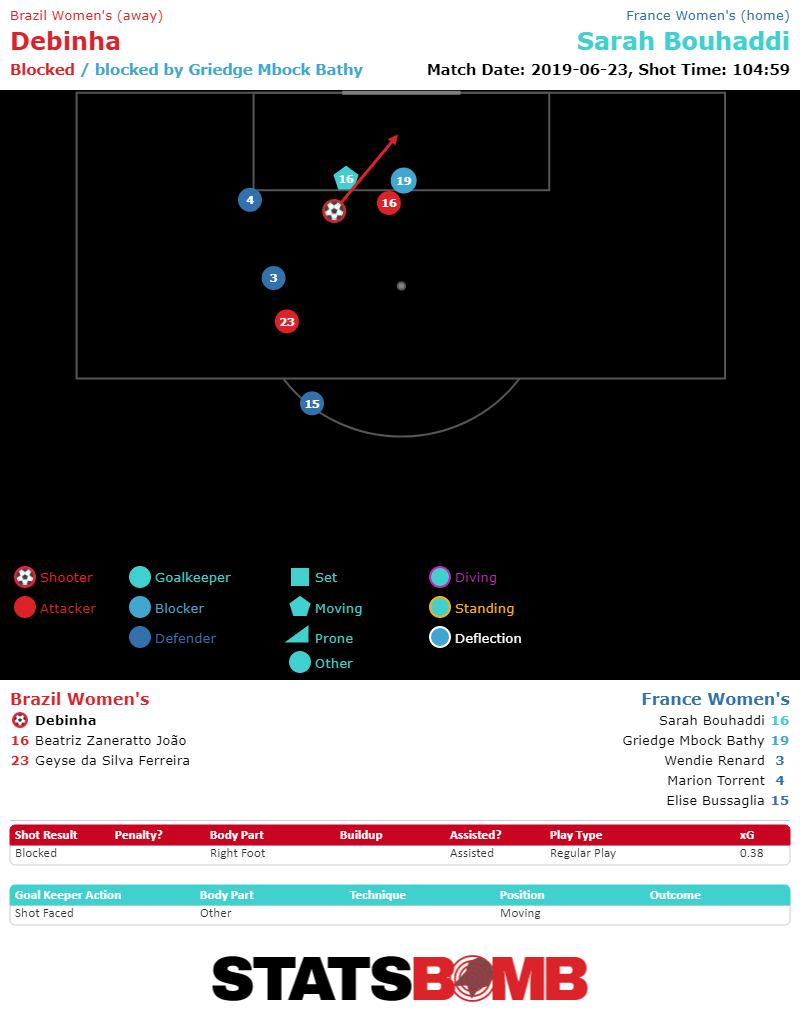 The irony of that moment is that it’s one of only two shots that Brazil managed after the regulation 90 minutes were finished. Cristiane took an early long-range audacious effort before being forced off through injury, but other than the spectacular Debinha attempt, that was it for Brazil. France meanwhile poured on the pressure, taking eight shots (after only taking six in the first 90 minutes) including Amandine Henry’s winning header. France have an immensely talented squad but they have largely chosen to deploy that squad to win games with as little defensive risk as possible. Against Brazil that meant a conservative 90 minutes. But when regulation finished, the approach changed. They ramped up the pressure, poured on the shots, and also gave away an extremely dangerous counterattack, which, if not for a defensive miracle could have seen them shockingly sent home. On balance, they were the better team, but the France approach is supposed to insulate them from conceding exactly the kind of high value shot that Brazil put on them in extra time. There’s no doubt that France and the U.S. are the two best teams in this World Cup. They came in as favorites, and they remain so. But, if the tournament has taught us anything, it’s not that the two teams expected weaknesses can be exploited, rather it’s that both Spain and Brazil were able, for stretches of time, to make the parts of the favorites’ game that were supposed to be their strengths, appear relatively ordinary. After watching them struggle to break down Spain, France will feel better about their chances to hold the U.S. And after watching Debinha come within inches of knocking France out, the U.S. will see a defense that might be there for the taking. On Friday we’ll see if that changes either side’s plan of attack. Header image courtesy of the Press Association
The irony of that moment is that it’s one of only two shots that Brazil managed after the regulation 90 minutes were finished. Cristiane took an early long-range audacious effort before being forced off through injury, but other than the spectacular Debinha attempt, that was it for Brazil. France meanwhile poured on the pressure, taking eight shots (after only taking six in the first 90 minutes) including Amandine Henry’s winning header. France have an immensely talented squad but they have largely chosen to deploy that squad to win games with as little defensive risk as possible. Against Brazil that meant a conservative 90 minutes. But when regulation finished, the approach changed. They ramped up the pressure, poured on the shots, and also gave away an extremely dangerous counterattack, which, if not for a defensive miracle could have seen them shockingly sent home. On balance, they were the better team, but the France approach is supposed to insulate them from conceding exactly the kind of high value shot that Brazil put on them in extra time. There’s no doubt that France and the U.S. are the two best teams in this World Cup. They came in as favorites, and they remain so. But, if the tournament has taught us anything, it’s not that the two teams expected weaknesses can be exploited, rather it’s that both Spain and Brazil were able, for stretches of time, to make the parts of the favorites’ game that were supposed to be their strengths, appear relatively ordinary. After watching them struggle to break down Spain, France will feel better about their chances to hold the U.S. And after watching Debinha come within inches of knocking France out, the U.S. will see a defense that might be there for the taking. On Friday we’ll see if that changes either side’s plan of attack. Header image courtesy of the Press Association
Author: Kevin Lawson
João Cancelo can be a perfect fit for Manchester City
João Cancelo is an attacking force. He was a vitally important cog in the attacking system that Max Allegri employed at Juventus. He’d be an absolutely perfect addition for Pep Guardiola’s Manchester City side should a rumored transfer go through. 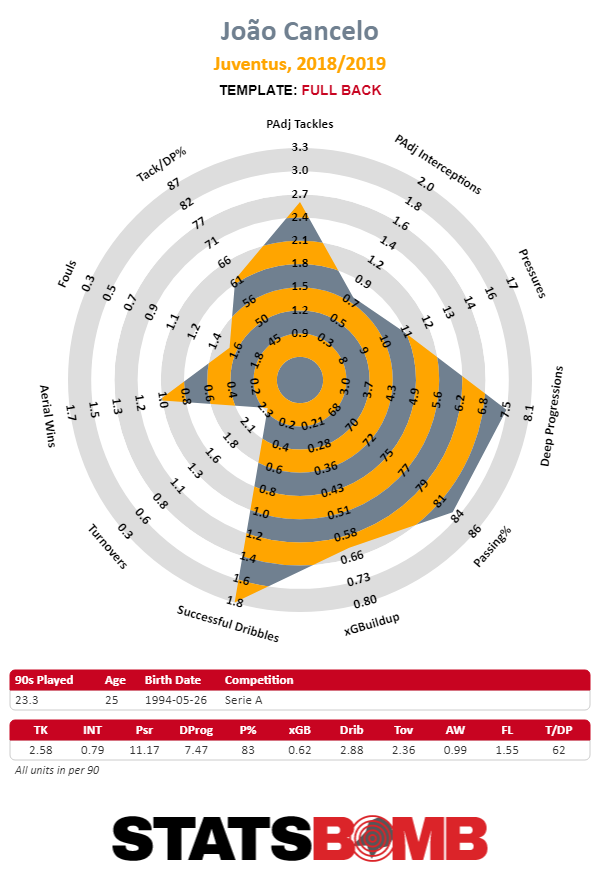 In some ways Cancelo profiles exactly like you might expect a young, aggressive, attacking fullback to. He gets forward down the wing and crosses the ball a lot. Of Juventus players who logged at least 900 league minutes, only Juan Cuadrado completed more crosses than Cancelo’s 1.89 per 90 minutes.
In some ways Cancelo profiles exactly like you might expect a young, aggressive, attacking fullback to. He gets forward down the wing and crosses the ball a lot. Of Juventus players who logged at least 900 league minutes, only Juan Cuadrado completed more crosses than Cancelo’s 1.89 per 90 minutes. 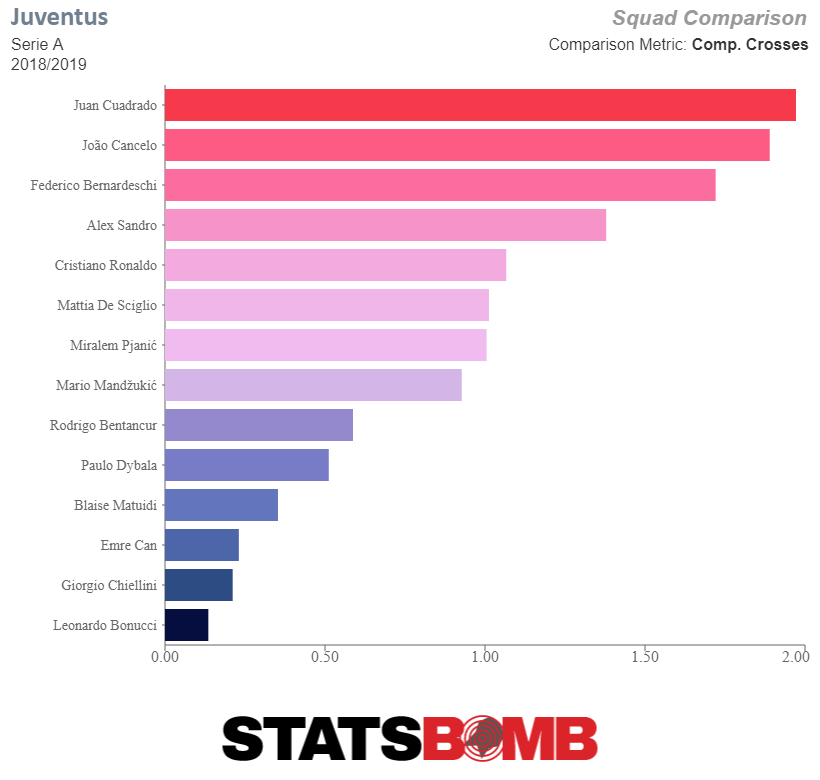 In fact, Cancelo’s service was integral to the Juventus attack. Only the attackers Fernando Bernadeschi and Cristiano Ronaldo assisted more expected goals from open play than Cancelo’s 0.12 per 90 minutes.
In fact, Cancelo’s service was integral to the Juventus attack. Only the attackers Fernando Bernadeschi and Cristiano Ronaldo assisted more expected goals from open play than Cancelo’s 0.12 per 90 minutes. 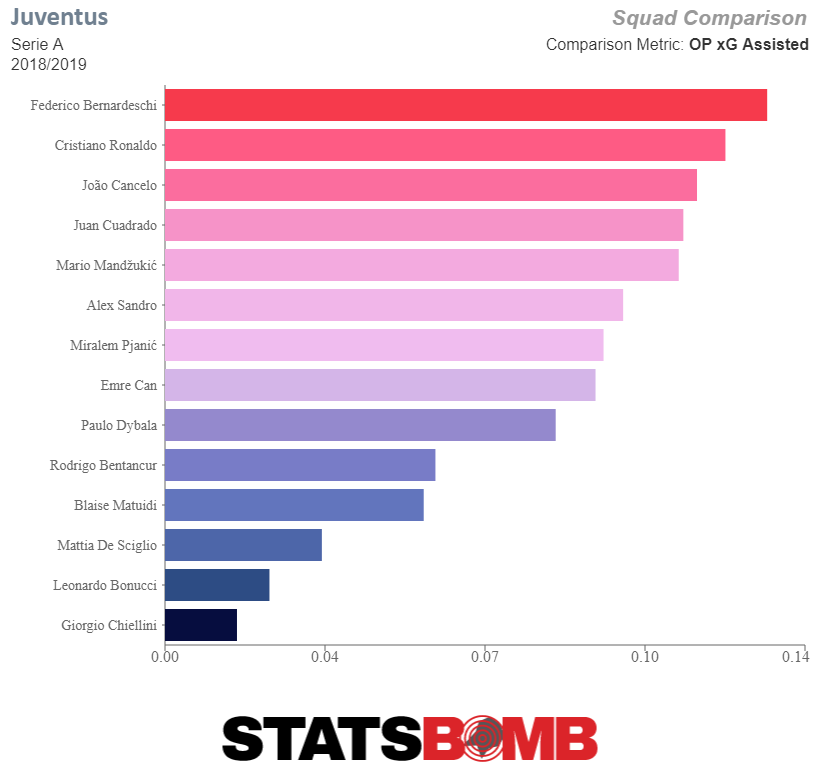 Where Cancelo separates himself from other fullbacks is that in addition to providing attacking width in the final third, he was a huge asset when it came to bringing the ball up the field. Only Miralem Pjanić, the team’s midfield hub, had more deep progressions of the ball per 90 minutes than Cancelo’s 7.47.
Where Cancelo separates himself from other fullbacks is that in addition to providing attacking width in the final third, he was a huge asset when it came to bringing the ball up the field. Only Miralem Pjanić, the team’s midfield hub, had more deep progressions of the ball per 90 minutes than Cancelo’s 7.47. 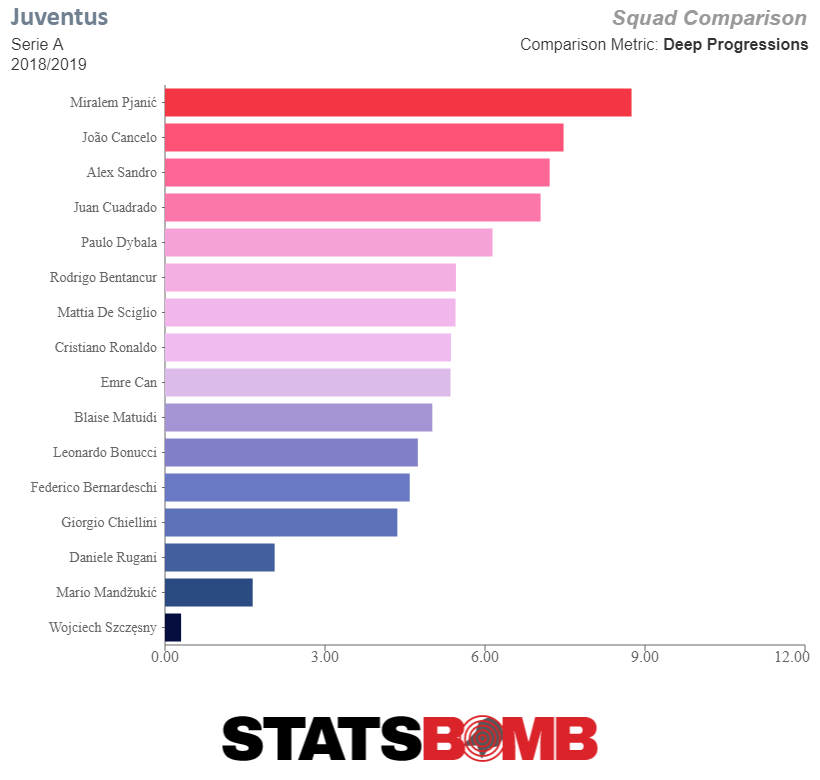 When teams looked to shutdown Pjanić’s passing, it was Cancelo who would step into the gap and transition Juventus into the attacking third of the field. Of course, some of this ability is system driven. On the opposite flank, Alex Sandro was third in deep progressions, and Cuadrado (who despite nominally being a winger largely played the same role as Cancelo), was fourth. But, at the same time, systems are often driven by talent. Juventus couldn’t have succeeded while playing a style that demanded their fullbacks bring the ball up the field if the fullbacks were not, themselves, special talents who were up to the task. So, it seems notable that backup fullback Matteo De Sciglio was not able to replicate those numbers in his minutes, and had a full two fewer deep progressions per 90 when he was on the field. The system empowered the fullbacks but Cancelo (and Sandro) had the ability to take advantage of it. The knock on Cancelo, from Juventus’s perspective was his defending. Over the course of the season he was often overlooked in big matches. This is probably a fair concern, especially for a team that was happy to play extremely defensively in big matches, especially with a one goal lead. And, not only to play defensively, but to defend without the ball. When they were dominating teams they were happy for midfielders to step up and win the ball, as their Serie A defensive heatmap shows.
When teams looked to shutdown Pjanić’s passing, it was Cancelo who would step into the gap and transition Juventus into the attacking third of the field. Of course, some of this ability is system driven. On the opposite flank, Alex Sandro was third in deep progressions, and Cuadrado (who despite nominally being a winger largely played the same role as Cancelo), was fourth. But, at the same time, systems are often driven by talent. Juventus couldn’t have succeeded while playing a style that demanded their fullbacks bring the ball up the field if the fullbacks were not, themselves, special talents who were up to the task. So, it seems notable that backup fullback Matteo De Sciglio was not able to replicate those numbers in his minutes, and had a full two fewer deep progressions per 90 when he was on the field. The system empowered the fullbacks but Cancelo (and Sandro) had the ability to take advantage of it. The knock on Cancelo, from Juventus’s perspective was his defending. Over the course of the season he was often overlooked in big matches. This is probably a fair concern, especially for a team that was happy to play extremely defensively in big matches, especially with a one goal lead. And, not only to play defensively, but to defend without the ball. When they were dominating teams they were happy for midfielders to step up and win the ball, as their Serie A defensive heatmap shows. 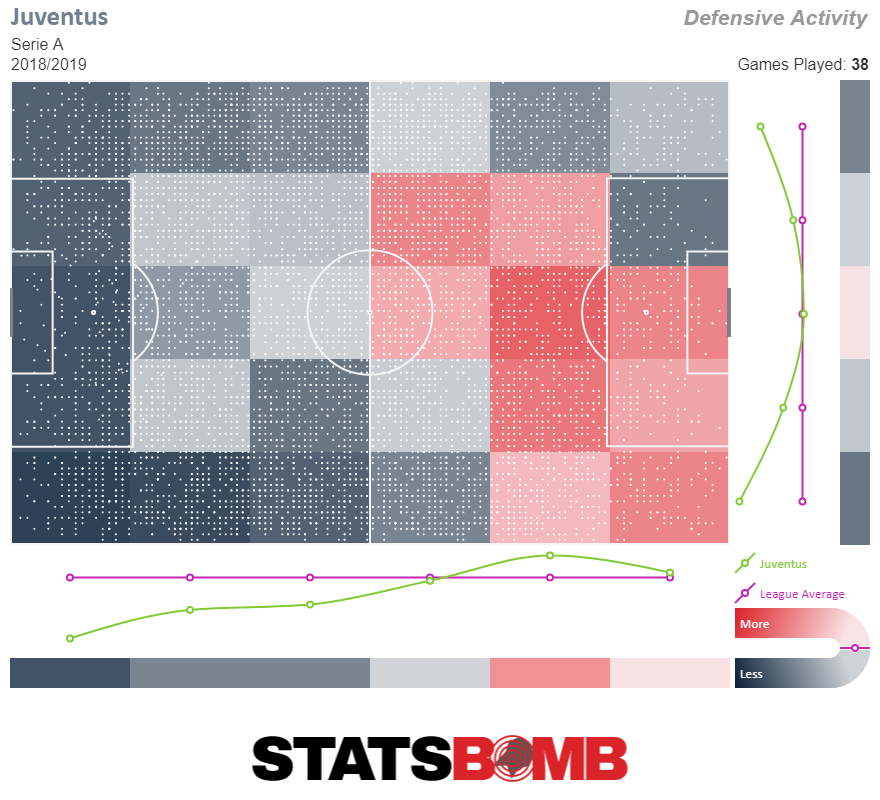 But, the difference becomes clear when looking at the Champions League, where the side’s defensive pressure is non-existent.
But, the difference becomes clear when looking at the Champions League, where the side’s defensive pressure is non-existent. 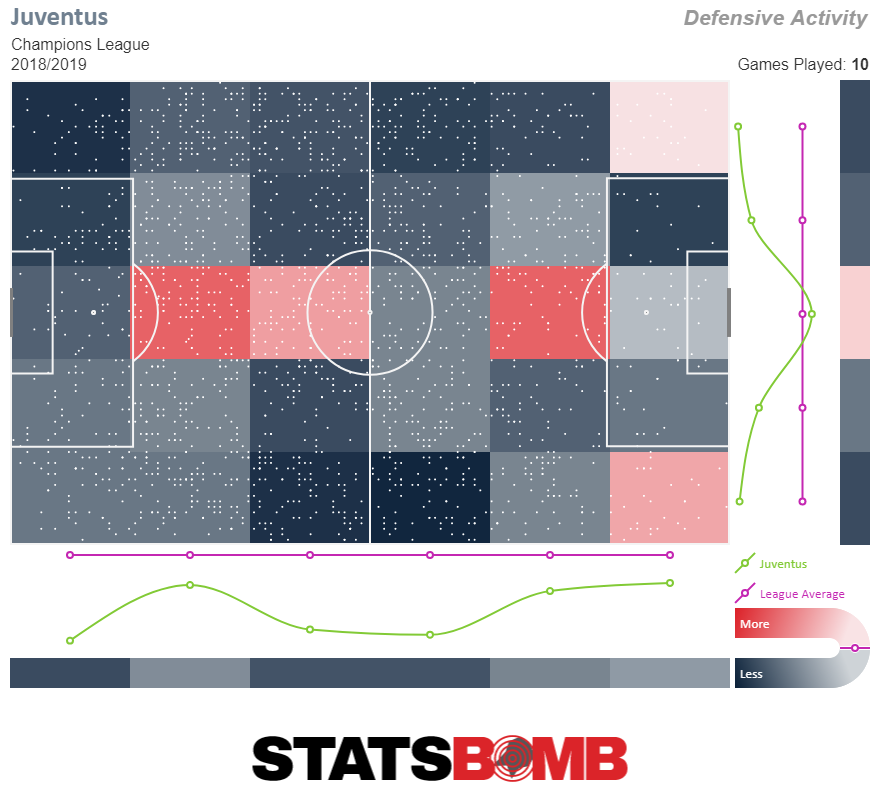 Within that framework, Cancelo is expected to be a perfect positional defender. He needs to move in concert with his teammates, covering runners, maintaining a defensive line, closing off passing lanes, and never make a mistake. In the same way that Allegri’s attacking approach empowered Cancelo, the manager’s defensive choices made his life difficult. Sometimes the defensive needs of the team ended up outweighing his attacking contribution and he found himself riding the pine. There’s a reason he barely topped 2000 league minutes last season. At Manchester City it’s easy to see how Cancelo’s attacking talents might be used. As Kyle Walker has aged he’s gracefully transformed from the speedster controlling the entire flank he once was into a more positionally oriented fullback, often supporting the midfield in attack and playing as almost a third central defender (the role he actually occupied for England at last summer’s men’s World Cup). Having the option to play Cancelo there would give Guardiola the option of playing a fullback who provided more traditional final third contributions (much like Benjamin Mendy does when healthy on the left side). Crucially though, Cancelo brings that ability while also bringing the passing ability in the middle of the field that Guardiola craves from his fullbacks. He’d most likely spend more time in the final third than Walker, while also moving the ball up the field just as much. The interactions between City’s fullbacks and wingers are a key to their success. Guardiola uses different combinations of personnel to accomplish different tactical aims. Sometimes wingers are asked to cut inside and attack the penalty area while fullbacks provide width, sometimes the wingers stay wide and the fullback is held in reserve, while the midfielder attacks the holes that spacing creates. And sometimes the fullback is the one who gets to attack the box aided by wingers positioned wide to stretch the defense. Cancelo can, in theory, fill all of those roles should he be called upon to do so (he can also, its worth noting, fill in on the left if necessary). The major question then is whether Cancelo can pull his weight defensively, an area that Walker has excelled in. The answer is, we have absolutely no idea. He’s never been asked to play in a system like Guardiola’s. At Juventus his problem wasn’t that he got caught up field, it was that while he was defending behind the ball, his awareness wasn’t sharp enough, at least for the exacting standards of Juventus. But, he won’t be asked to defend that way for Manchester City. While it’s unclear exactly how he will be deployed, one thing is certain, City don’t ever want to defend without the ball. Sometimes the fullback is asked to engage high up the field, as part of a traditional counter-press. Other times they might be held in reserve, forming a makeshift back three with the center backs, behind the frontline press of the midfielders and forwards. These were situations he just never has to deal with when manning the right side for Juventus. Maybe he’ll be spectacular, maybe he’ll have a hard time adjusting, there’s not a lot either way to hang a prediction on. But that question, whether Cancelo is good enough defensively for what may very well be the best team in the world, is one that simply differentiates whether Cancelo will be a useful piece, or is the heir apparent to Walker as an every week starter. Cancelo’s attacking numbers are so strong, and so well rounded that there’s no doubt he’ll be an extremely useful contributor for City. But, if he adds to that, and he develops into a solid defensive option in a pressing system, then he has the potential to become truly great. He’d become just another superstar player bought at superstar prices to fill a supporting role for the two time defending Premier League champions.
Within that framework, Cancelo is expected to be a perfect positional defender. He needs to move in concert with his teammates, covering runners, maintaining a defensive line, closing off passing lanes, and never make a mistake. In the same way that Allegri’s attacking approach empowered Cancelo, the manager’s defensive choices made his life difficult. Sometimes the defensive needs of the team ended up outweighing his attacking contribution and he found himself riding the pine. There’s a reason he barely topped 2000 league minutes last season. At Manchester City it’s easy to see how Cancelo’s attacking talents might be used. As Kyle Walker has aged he’s gracefully transformed from the speedster controlling the entire flank he once was into a more positionally oriented fullback, often supporting the midfield in attack and playing as almost a third central defender (the role he actually occupied for England at last summer’s men’s World Cup). Having the option to play Cancelo there would give Guardiola the option of playing a fullback who provided more traditional final third contributions (much like Benjamin Mendy does when healthy on the left side). Crucially though, Cancelo brings that ability while also bringing the passing ability in the middle of the field that Guardiola craves from his fullbacks. He’d most likely spend more time in the final third than Walker, while also moving the ball up the field just as much. The interactions between City’s fullbacks and wingers are a key to their success. Guardiola uses different combinations of personnel to accomplish different tactical aims. Sometimes wingers are asked to cut inside and attack the penalty area while fullbacks provide width, sometimes the wingers stay wide and the fullback is held in reserve, while the midfielder attacks the holes that spacing creates. And sometimes the fullback is the one who gets to attack the box aided by wingers positioned wide to stretch the defense. Cancelo can, in theory, fill all of those roles should he be called upon to do so (he can also, its worth noting, fill in on the left if necessary). The major question then is whether Cancelo can pull his weight defensively, an area that Walker has excelled in. The answer is, we have absolutely no idea. He’s never been asked to play in a system like Guardiola’s. At Juventus his problem wasn’t that he got caught up field, it was that while he was defending behind the ball, his awareness wasn’t sharp enough, at least for the exacting standards of Juventus. But, he won’t be asked to defend that way for Manchester City. While it’s unclear exactly how he will be deployed, one thing is certain, City don’t ever want to defend without the ball. Sometimes the fullback is asked to engage high up the field, as part of a traditional counter-press. Other times they might be held in reserve, forming a makeshift back three with the center backs, behind the frontline press of the midfielders and forwards. These were situations he just never has to deal with when manning the right side for Juventus. Maybe he’ll be spectacular, maybe he’ll have a hard time adjusting, there’s not a lot either way to hang a prediction on. But that question, whether Cancelo is good enough defensively for what may very well be the best team in the world, is one that simply differentiates whether Cancelo will be a useful piece, or is the heir apparent to Walker as an every week starter. Cancelo’s attacking numbers are so strong, and so well rounded that there’s no doubt he’ll be an extremely useful contributor for City. But, if he adds to that, and he develops into a solid defensive option in a pressing system, then he has the potential to become truly great. He’d become just another superstar player bought at superstar prices to fill a supporting role for the two time defending Premier League champions.
Three misleading results from the World Cup's opening weekend
Oftentimes the final score obscures the true story of a match. Here are three results from the opening weekend that don’t reflect the underlying performances of the teams involved.
Norway 3-0 Nigeria
Norway walked away from their opener with Nigeria comfortable 3-0 victors, but the result doesn’t really tell the tale. While the two teams were quite clearly stylistically different, the match itself was, for long stretches, conducted on extremely even footing. Both teams played a fast, vertical style. Norway focused on getting the ball to their talented strikers early, with their wingers pinching in to provide service. 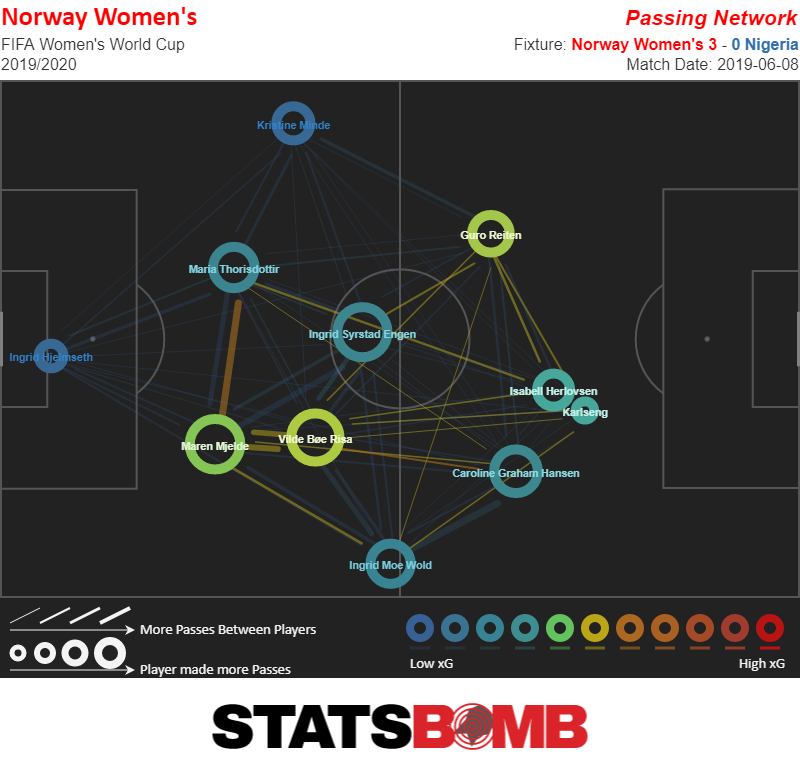 Nigeria played the ball wide to Franny Ordega.
Nigeria played the ball wide to Franny Ordega. 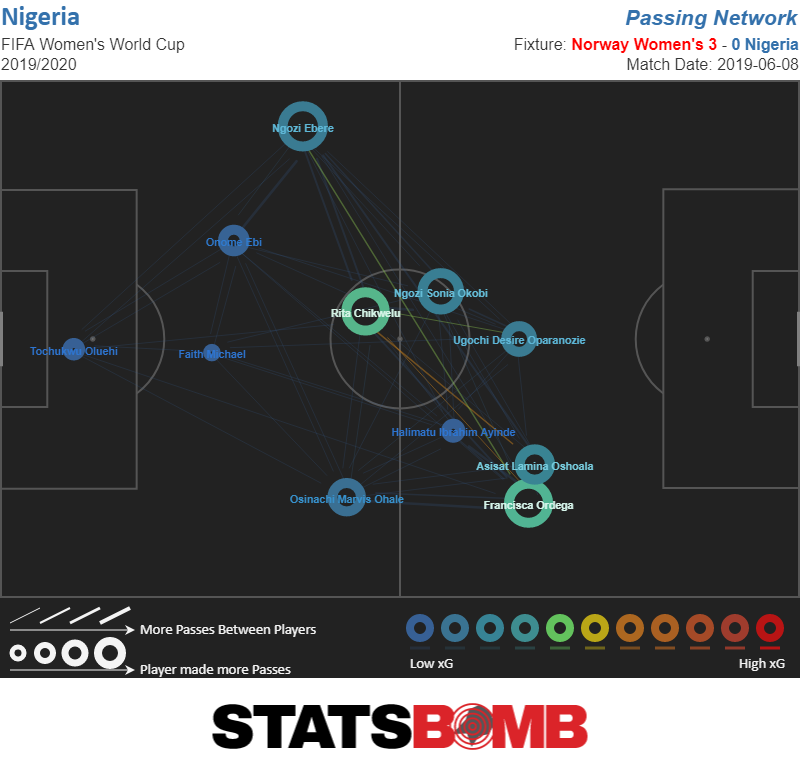 But the results were similar. Both teams created ten chances, and both created similar expected goals totals. Norway just had both a deflection that ended up in the back of the net and an own goal to help them, while Nigeria got no such luck.
But the results were similar. Both teams created ten chances, and both created similar expected goals totals. Norway just had both a deflection that ended up in the back of the net and an own goal to help them, while Nigeria got no such luck. 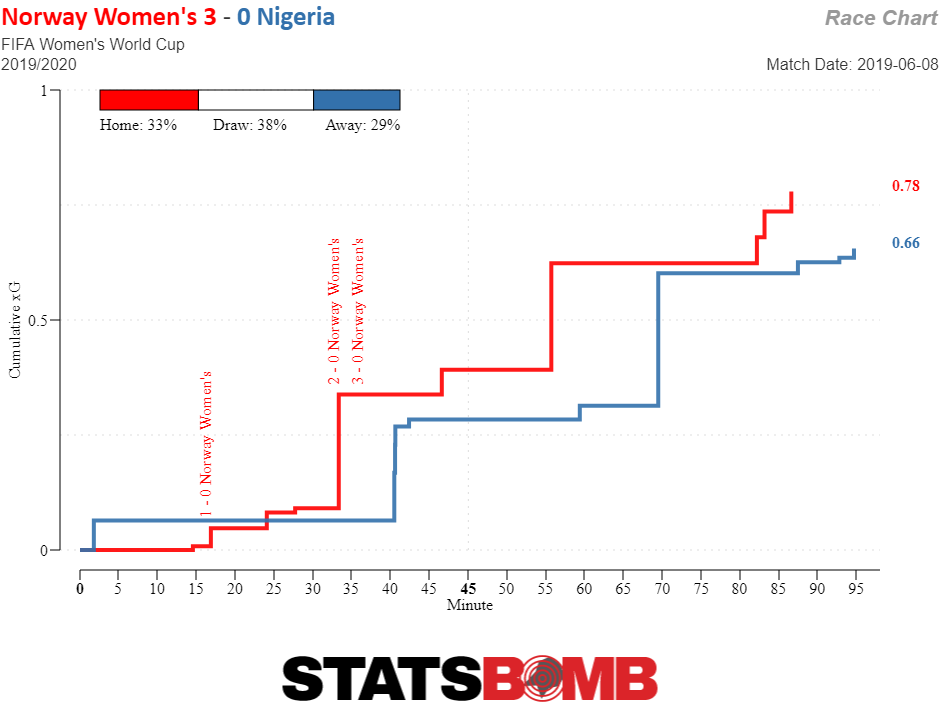 It’s true that this framing somewhat undervalues Norway. Their opener might not go down as a high xG chance, but the move, from a short corner, was defended extremely poorly by Nigeria, in ways that an xG model might fail to properly account for. Their second goal was the result of a gorgeous defense splitting ball from Guro Reiten which left Lisa-Marie Karlseng Utland through on goal, albeit from a tough angle that required her to absolutely murder the ball to score (and perhaps still should have been handled better by Tochukwu Oluehi).
It’s true that this framing somewhat undervalues Norway. Their opener might not go down as a high xG chance, but the move, from a short corner, was defended extremely poorly by Nigeria, in ways that an xG model might fail to properly account for. Their second goal was the result of a gorgeous defense splitting ball from Guro Reiten which left Lisa-Marie Karlseng Utland through on goal, albeit from a tough angle that required her to absolutely murder the ball to score (and perhaps still should have been handled better by Tochukwu Oluehi). 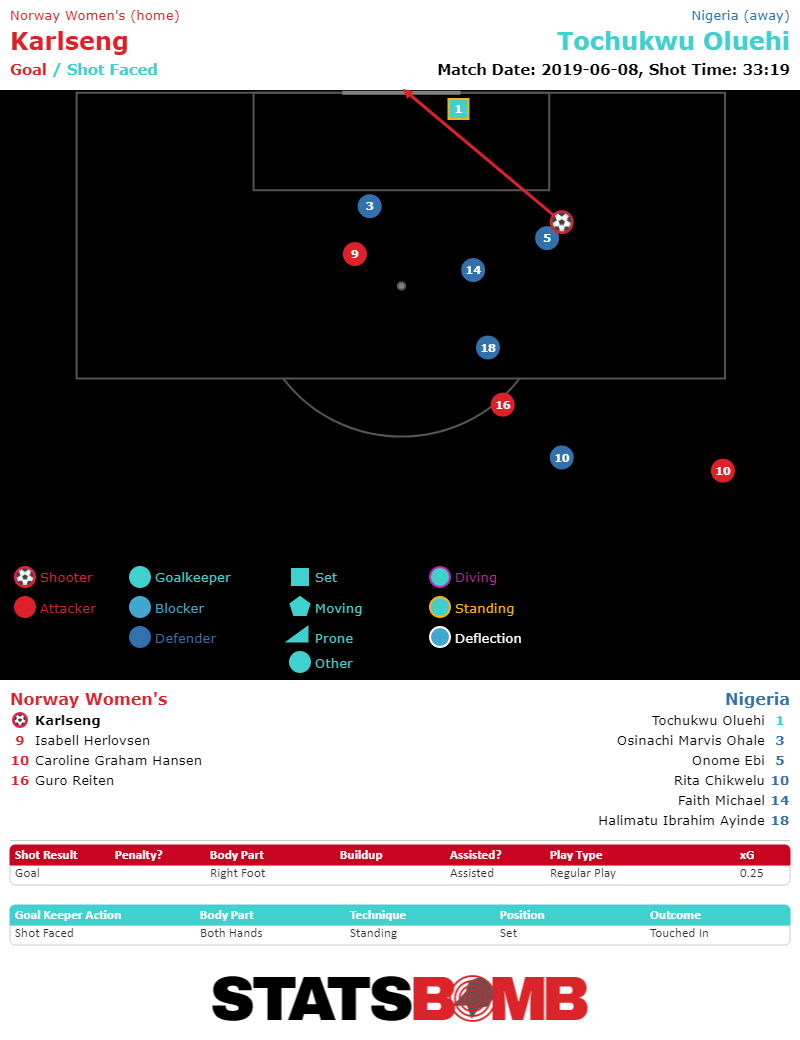 And the goal Nigeria put in the back of their own net was generated from a dangerous attack, which doesn’t go down as a shot generated, since the defense managed to do all the damage themselves. All of which is to say that while the xG model might have these two teams as extremely even, and the goals had it extremely lopsided, the truth is probably somewhere in the middle. Norway was better than Nigeria, but not all that much better. Does it matter? Well, maybe. The result is a brutal blow for Nigeria in a group where France is almost certainly going to run away with first place, and Norway now has a mammoth goal difference in the race for second. The three goal defeat also makes it that much harder for them to get one of the four third place spots that advance. But, it also means that we shouldn’t write off their chances of putting a big result up against South Korea, and keeping it tight against France. They also have the good fortune to play against the hosts in the third group stage game when the favorites will possibly only need a draw to ensure first place in the group. Nigeria have a difficult road ahead but don’t count them out because of a single lopsided score line.
And the goal Nigeria put in the back of their own net was generated from a dangerous attack, which doesn’t go down as a shot generated, since the defense managed to do all the damage themselves. All of which is to say that while the xG model might have these two teams as extremely even, and the goals had it extremely lopsided, the truth is probably somewhere in the middle. Norway was better than Nigeria, but not all that much better. Does it matter? Well, maybe. The result is a brutal blow for Nigeria in a group where France is almost certainly going to run away with first place, and Norway now has a mammoth goal difference in the race for second. The three goal defeat also makes it that much harder for them to get one of the four third place spots that advance. But, it also means that we shouldn’t write off their chances of putting a big result up against South Korea, and keeping it tight against France. They also have the good fortune to play against the hosts in the third group stage game when the favorites will possibly only need a draw to ensure first place in the group. Nigeria have a difficult road ahead but don’t count them out because of a single lopsided score line.
Germany 1-0 China
China had Germany right where they wanted them. Germany are one of the favorites to win the entire tournament. They have more talent than China at virtually every position. They meticulously work the ball forward and try and generate high quality looks for their forward Alexandra Popp supported by wingers Svenja Huth and Giulia Gwinn as well as midfielders Sara Däbritz and Dzsenifer Marozsan. It’s a pretty plan. It also led to a shot char that looks like this. That’s 16 shots, none of them particularly exciting 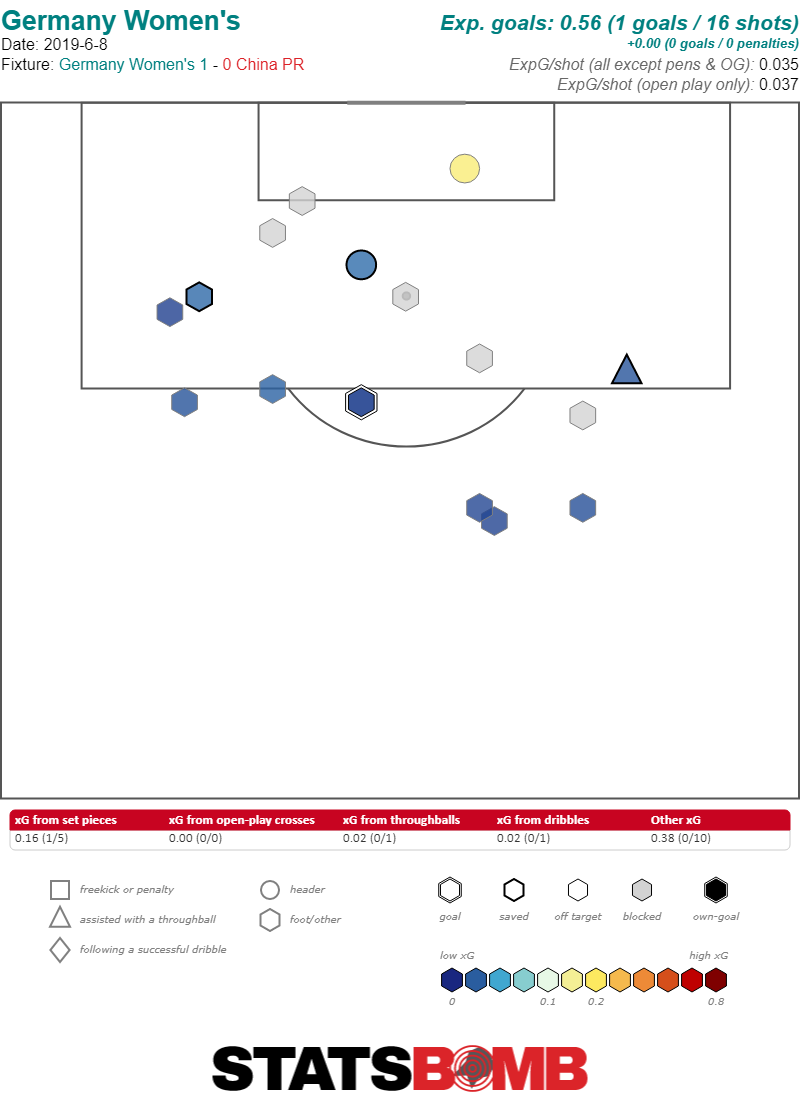 China, on the other hand (or foot as the case may be), decided their best chance at success was to allow Germany to have possession, and then kick them, take the ball away and counterattack at lightening speed. They created only five chances, but those five chances were truly golden ones. Despite the shot differential China actually created more expected goals over the course of the match than Germany.
China, on the other hand (or foot as the case may be), decided their best chance at success was to allow Germany to have possession, and then kick them, take the ball away and counterattack at lightening speed. They created only five chances, but those five chances were truly golden ones. Despite the shot differential China actually created more expected goals over the course of the match than Germany. 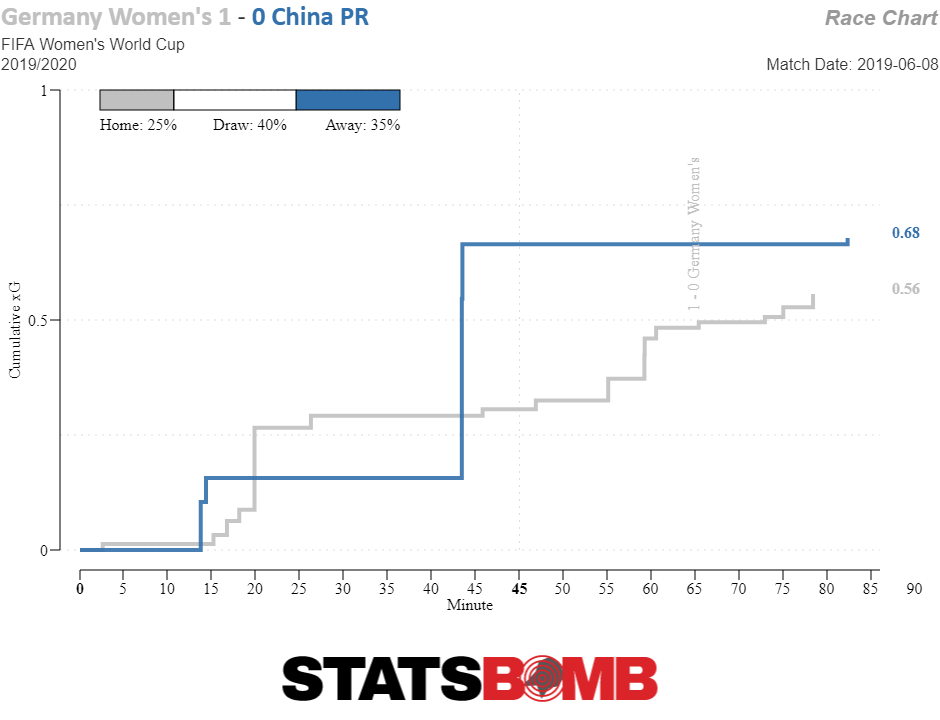 The good news for Germany is that whatever vulnerability China exploited to create those first half chances, the favorites shored it up at half time. China didn’t have a single chance on goal after the break. The bad news is that it took an absolute stunner from distance from Gwinn for Germany to break through at the attacking end. The question of whether to credit China or blame Germany for an end result that was a lot less one sided than expected is difficult. We’ll learn more over the next two matches. Germany’s next opponent is Spain, a team whose skill lies in their own possession play. If Germany can’t break them down, not only should alarm bells start going off, but flashing red emergency sirens should be everywhere, with the loudspeaker announcing an emergency evacuation of the German bandwagon. Meanwhile, China take on a South Africa side that gave Spain a surprisingly difficult match for 60 minutes. Still, if China want to be considered as anything more than a team that played a mildly surprising opening first match they’ll need to show they can handle one of the weaker teams in the tournament with ease.
The good news for Germany is that whatever vulnerability China exploited to create those first half chances, the favorites shored it up at half time. China didn’t have a single chance on goal after the break. The bad news is that it took an absolute stunner from distance from Gwinn for Germany to break through at the attacking end. The question of whether to credit China or blame Germany for an end result that was a lot less one sided than expected is difficult. We’ll learn more over the next two matches. Germany’s next opponent is Spain, a team whose skill lies in their own possession play. If Germany can’t break them down, not only should alarm bells start going off, but flashing red emergency sirens should be everywhere, with the loudspeaker announcing an emergency evacuation of the German bandwagon. Meanwhile, China take on a South Africa side that gave Spain a surprisingly difficult match for 60 minutes. Still, if China want to be considered as anything more than a team that played a mildly surprising opening first match they’ll need to show they can handle one of the weaker teams in the tournament with ease.
Australia 1 – 2 Italy
Speaking of alarm bells, Australia, a dark horse contender to go deep in the tournament lost their opener to Italy. This one is less concerning than it seemed at first glance. 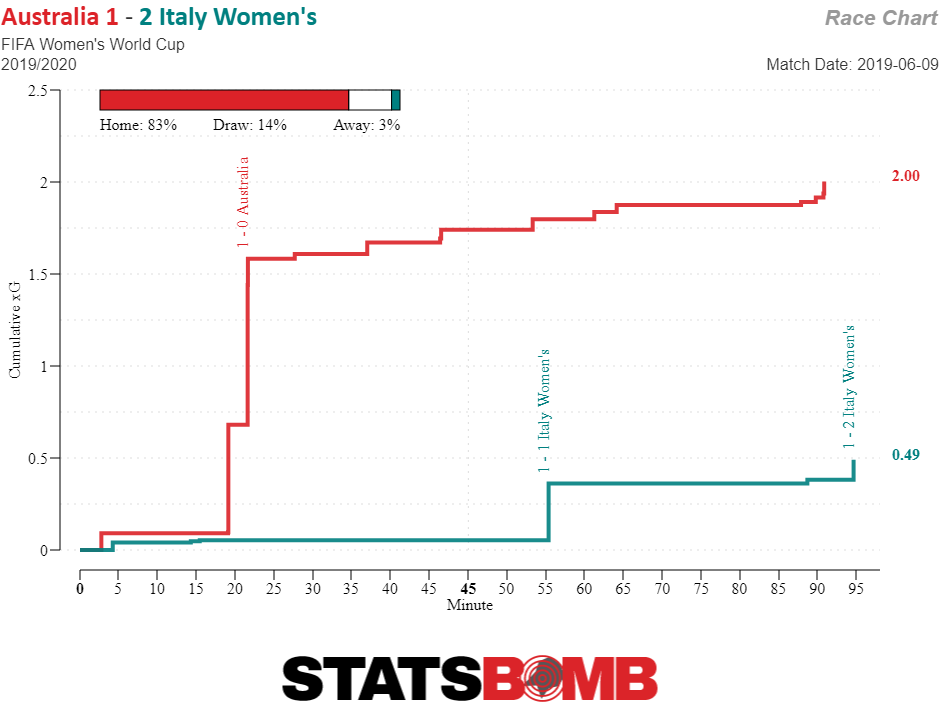 Italy threatened to get in behind Australia’s back line all match long, but they didn’t often actually succeed. They only generated six shots over the entire match. And they didn’t have a single one between the 15th minute, and the 55th when they equalized, and had only two between then and the end of the match. It just how happens that the second one was a dramatic 94th minute game winner. There are definitely some things Australia should be concerned about. Despite creating a number of strong chances early on, after going up a goal they simply weren’t able to put the game away. They took 11 shots, but not a single one registered as even 0.10 on the ol’ xG meter. Even after Italy tied the match, Australia never really poured pressure on. If you let the underdog hang around, sometimes they’re going to nip you at the wire. As for Italy, these three points were desperately important. With Australia still seeming like they’re fine, and Brazil trouncing Jamaica 3-0 in the opener despite star Marta missing out due to injury, Group C seems incredibly competitive. Italy was going to need to get some fortunate points somewhere to have a chance of advancing. Now, if they can follow up this surprise victory with an easier win against Jamaica on Friday they’ll be sitting pretty to move through to the knockout stage. Header image courtesy of the Press Association
Italy threatened to get in behind Australia’s back line all match long, but they didn’t often actually succeed. They only generated six shots over the entire match. And they didn’t have a single one between the 15th minute, and the 55th when they equalized, and had only two between then and the end of the match. It just how happens that the second one was a dramatic 94th minute game winner. There are definitely some things Australia should be concerned about. Despite creating a number of strong chances early on, after going up a goal they simply weren’t able to put the game away. They took 11 shots, but not a single one registered as even 0.10 on the ol’ xG meter. Even after Italy tied the match, Australia never really poured pressure on. If you let the underdog hang around, sometimes they’re going to nip you at the wire. As for Italy, these three points were desperately important. With Australia still seeming like they’re fine, and Brazil trouncing Jamaica 3-0 in the opener despite star Marta missing out due to injury, Group C seems incredibly competitive. Italy was going to need to get some fortunate points somewhere to have a chance of advancing. Now, if they can follow up this surprise victory with an easier win against Jamaica on Friday they’ll be sitting pretty to move through to the knockout stage. Header image courtesy of the Press Association
What to expect when Real Madrid is expecting Luka Jović
Luka Jović’s transfer to Real Madrid is a perfect marriage of skills and need. Jović is only 21 years old and he’s really really good at finding space to get shots for himself. Real Madrid are desperately in need of a high volume shooter to lead their attack. The young Serbian’s transfer from Eintracht Frankfurt to one of the biggest stages in the world should be a roaring success if manager Zinedine Zidane can successfully meld that skill to his team’s obvious need. Let’s start with Jović. Last season he took 3.70 shots per 90 minutes. That number places him third in the Bundesliga (among players who played at least 1500 minutes) behind only Bayern Munich’s Robert Lewandowski and Hoffenheim’s Ishak Belfodil. Across Europe’s big five leagues he’s 14th overall. Of the thirteen players ahead of him, only Kylian Mbappe is younger. Additionally, not a single one of Jović’s shots came from a direct free kick. Unlike some of the games most famous shot getters, Jović doesn’t get to pad the numbers with the kind of low expectation dead ball bombs that Cristiano Ronaldo is famous for taking and Lionel Messi converts at historic rates. It’s no surprise then that Jović’s expected goals per shot of 0.13 stacks of quite favorably against the players who shoot more than him. Only Mbappe, Lewandowski, Manchester City’s Sergio Aguero and Napoli’s Arkadiusz Milik (barely, at 0.14) both take more shots and have a higher per shot xG. Jović takes a lot of really good shots. It’s what he does. 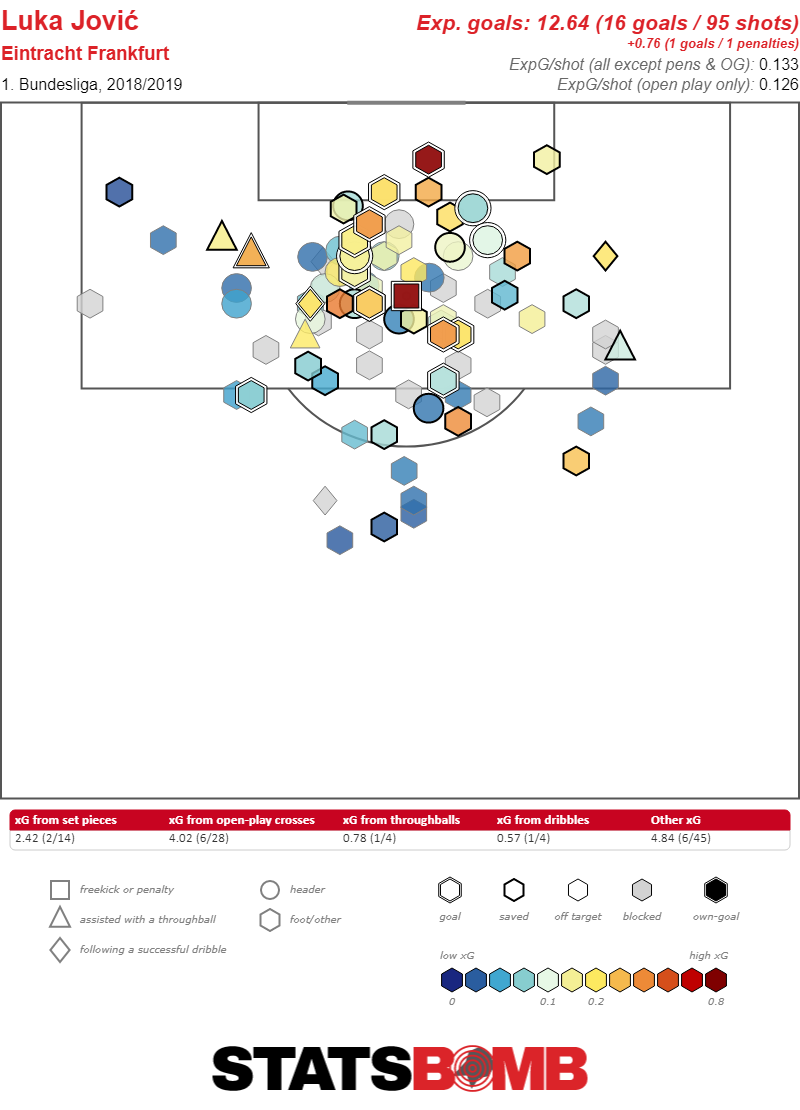 Real Madrid, meanwhile, desperately need a high-volume shooter and goal scorer. The team never replaced Ronaldo. Unsurprisingly, this made the team’s attack worse. They went from taking 18.58 shots per match, generating 1.91 xG per match in 2017-18 to taking 15.24 shots and 1.33 xG.
Real Madrid, meanwhile, desperately need a high-volume shooter and goal scorer. The team never replaced Ronaldo. Unsurprisingly, this made the team’s attack worse. They went from taking 18.58 shots per match, generating 1.91 xG per match in 2017-18 to taking 15.24 shots and 1.33 xG. 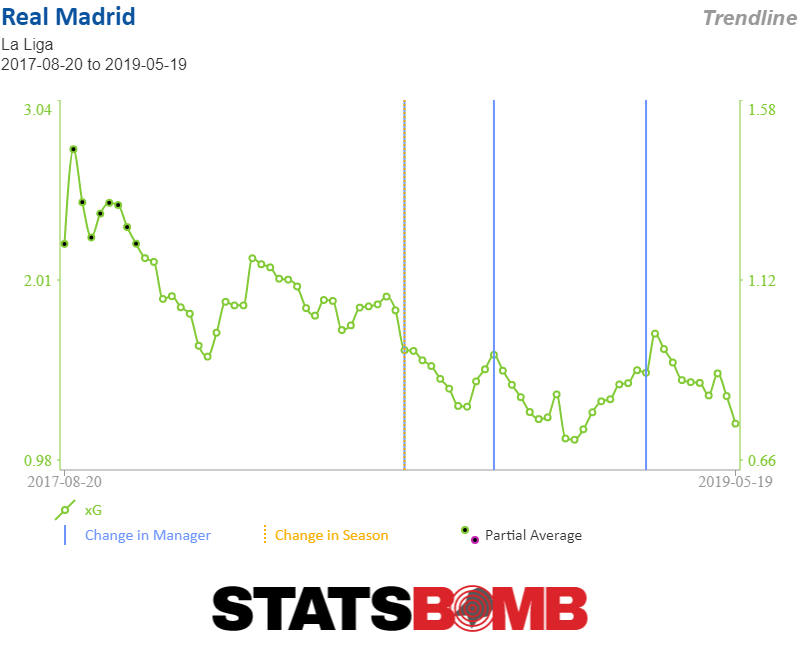 But, while Jović’s skills are a perfect answer to Madrid’s glaring need, integrating those skills tactically into the existing structure will be more complicated. For starters, the man who currently occupies the starting forward role on Madrid, Karim Benzema, despite being 31 years old, remains excellent. Even though his 21 league goals last season come with the caveat that three were penalties and the remaining 18 were pretty far ahead of his xG of 11.92, that shouldn’t take away from the fact that during a season full of chaos, he was a consistent rock leading the line, for much of the season as Madrid’s only real goal scoring threat. For years Benzema was the perfect foil for Ronaldo, facilitating Ronaldo’s high usage rate by only taking the best shots for himself while committing himself to doing much of the table setting. In Ronaldo’s last season, Benzema took only 2.28 shots per 90 minutes, but having an efficient xG per shot of 0.16. Put it all together and that ends up at 0.37 xG per 90. Last season he compensated for Ronaldo’s absence by shooting a little more, 2.89 times per 90, but a little less efficiently, 0.12 xG per shot (which sure doesn’t end up mattering when you have the kind of finishing season that Benzema did, just don’t expect that finishing season to happen again as a matter of course). The result was a strikingly similar 0.35 xG per 90. Averaging a little over a third of an expected goal per game is a little light for an elite forward, but Benzema more than makes up for it with his creative work. He brings so much to the table that it’s more than forgivable that his goal scoring is a touch worse than the best forwards in the world. But, after a year of watching him step into the scoring spotlight, and not see his xG climb much higher than it had been, it’s fair to say that for Madrid to operate at its best, they need a player who generates shots beside Benzema. The question shouldn’t be which of Benzema and Jović will start, but whether the two of them can play together. Answering that question involves talking about another transfer. Eden Hazard is, of course, widely rumored to be on his way to Madrid. That signing would complete the front three. The real question is can Hazard, Benzema and Jović all coexist. And it’s not clear that the answer to that question is yes, talented as all those players may be. We’ve talked about Benzema. Jović is certainly comfortable with a striker partner, he played as part of a narrow attacking trio at Frankfurt, with Sebastian Haller alongside and Ante Rebić slightly deeper. They were supported by wing backs in a very conservative system. It’d be different at Madrid obviously, but playing off Benzema should be well within his wheelhouse. Hazard, obviously has spent most of his career on the left of either a 4-3-3 or a 4-2-3-1 with occasional forays into center forwardom. So, what’s the problem? Well, during Zidane’s time implementing a system built around Ronaldo and Benzema, he consistently had to find solutions to keep the team more or less stable. The solutions took a few different forms. The rare moments when Gareth Bale was healthy he was such an athletic beast that he could fully contribute to the front three while also being a traditional winger defending one side of the pitch. Other times a more workmanlike third, Lucas Vázquez, was preferred. Or, finally, Zindane deployed an Isco type as the third, a player who has the possession control tendencies of a more traditional midfielder. Hazard is none of those things. The potential of this new front three is mouth-watering. Sure Jović isn’t yet, and probably never will become, Ronaldo, but with the added creativity of Hazard in the mix, that unit is likely to be as potent as the one that came before. But Zidane will have to find some way to balance that plan if he wants to keep from getting carved up by good teams at the other end. Maybe that means keeping the fullbacks conservatively positioned, or no longer being able to field increasingly immobile Luka Modric and the never very mobile Toni Kroos at the same time against good teams. Maybe it means another bigtime midfield signing (is that Paul Pogba’s music?). This is not an impossible tactical challenge to overcome, and it’s one that probably won’t rear its ugly head against bad teams beaten back under an onslaught, but it’s one that will lurk behind Zidane’s choices all season. Can he afford to start both strikers in big games against top notch opposition? If not, who sits? Does Hazard provide enough creativity that it makes sense to prioritize Jović over Benzema, or will Benzema’s all around great game bring out goal scoring in Hazard such that it’s Jović who misses out? Eventually this will work itself out. There will only be a couple of years at most where Benzema is still at the top of his game and Jović, provided he doesn’t struggle on the bigger stage, will become the starter before too long. But, in the meantime, for the upcoming season, Madrid’s primary tactical challenge will be whether or not a new look front three can all play together. If they can, Madrid’s time away from the top of Europe’s pyramid may be very short indeed.
But, while Jović’s skills are a perfect answer to Madrid’s glaring need, integrating those skills tactically into the existing structure will be more complicated. For starters, the man who currently occupies the starting forward role on Madrid, Karim Benzema, despite being 31 years old, remains excellent. Even though his 21 league goals last season come with the caveat that three were penalties and the remaining 18 were pretty far ahead of his xG of 11.92, that shouldn’t take away from the fact that during a season full of chaos, he was a consistent rock leading the line, for much of the season as Madrid’s only real goal scoring threat. For years Benzema was the perfect foil for Ronaldo, facilitating Ronaldo’s high usage rate by only taking the best shots for himself while committing himself to doing much of the table setting. In Ronaldo’s last season, Benzema took only 2.28 shots per 90 minutes, but having an efficient xG per shot of 0.16. Put it all together and that ends up at 0.37 xG per 90. Last season he compensated for Ronaldo’s absence by shooting a little more, 2.89 times per 90, but a little less efficiently, 0.12 xG per shot (which sure doesn’t end up mattering when you have the kind of finishing season that Benzema did, just don’t expect that finishing season to happen again as a matter of course). The result was a strikingly similar 0.35 xG per 90. Averaging a little over a third of an expected goal per game is a little light for an elite forward, but Benzema more than makes up for it with his creative work. He brings so much to the table that it’s more than forgivable that his goal scoring is a touch worse than the best forwards in the world. But, after a year of watching him step into the scoring spotlight, and not see his xG climb much higher than it had been, it’s fair to say that for Madrid to operate at its best, they need a player who generates shots beside Benzema. The question shouldn’t be which of Benzema and Jović will start, but whether the two of them can play together. Answering that question involves talking about another transfer. Eden Hazard is, of course, widely rumored to be on his way to Madrid. That signing would complete the front three. The real question is can Hazard, Benzema and Jović all coexist. And it’s not clear that the answer to that question is yes, talented as all those players may be. We’ve talked about Benzema. Jović is certainly comfortable with a striker partner, he played as part of a narrow attacking trio at Frankfurt, with Sebastian Haller alongside and Ante Rebić slightly deeper. They were supported by wing backs in a very conservative system. It’d be different at Madrid obviously, but playing off Benzema should be well within his wheelhouse. Hazard, obviously has spent most of his career on the left of either a 4-3-3 or a 4-2-3-1 with occasional forays into center forwardom. So, what’s the problem? Well, during Zidane’s time implementing a system built around Ronaldo and Benzema, he consistently had to find solutions to keep the team more or less stable. The solutions took a few different forms. The rare moments when Gareth Bale was healthy he was such an athletic beast that he could fully contribute to the front three while also being a traditional winger defending one side of the pitch. Other times a more workmanlike third, Lucas Vázquez, was preferred. Or, finally, Zindane deployed an Isco type as the third, a player who has the possession control tendencies of a more traditional midfielder. Hazard is none of those things. The potential of this new front three is mouth-watering. Sure Jović isn’t yet, and probably never will become, Ronaldo, but with the added creativity of Hazard in the mix, that unit is likely to be as potent as the one that came before. But Zidane will have to find some way to balance that plan if he wants to keep from getting carved up by good teams at the other end. Maybe that means keeping the fullbacks conservatively positioned, or no longer being able to field increasingly immobile Luka Modric and the never very mobile Toni Kroos at the same time against good teams. Maybe it means another bigtime midfield signing (is that Paul Pogba’s music?). This is not an impossible tactical challenge to overcome, and it’s one that probably won’t rear its ugly head against bad teams beaten back under an onslaught, but it’s one that will lurk behind Zidane’s choices all season. Can he afford to start both strikers in big games against top notch opposition? If not, who sits? Does Hazard provide enough creativity that it makes sense to prioritize Jović over Benzema, or will Benzema’s all around great game bring out goal scoring in Hazard such that it’s Jović who misses out? Eventually this will work itself out. There will only be a couple of years at most where Benzema is still at the top of his game and Jović, provided he doesn’t struggle on the bigger stage, will become the starter before too long. But, in the meantime, for the upcoming season, Madrid’s primary tactical challenge will be whether or not a new look front three can all play together. If they can, Madrid’s time away from the top of Europe’s pyramid may be very short indeed.
Barcelona Season Review: So That Happened....Again
How do you evaluate a team when only one game mattered?
Barcelona won La Liga by 11 points. It was the team’s second title in a row, fourth out of the last five, sixth out of the last eight and eighth out of the last 11. Their season was also, by all accounts, an utter failure. For the second straight season the team blew a massive lead halfway through a tie to get unceremoniously dumped out of the Champions League.
The fact that the Liverpool team that sent them home this time was significantly better than the Roma side that delivered the blow last year doesn’t really make an extremely bitter pill go down any easier. It’s hard to reconcile sustained dominance and prominent failure into a coherent narrative. One place to start, however, is by recognizing that Barcelona’s overall performance has, in fact, declined. Over the past two seasons, Barcelona’s attack has increasingly become less prominent in order to maintain a, more or less, consistent level of defensive strength.
Of course, when you have Lionel Messi that decline simply means going from stratospheric levels to simply superhuman ones. Barcelona still had the best attack in La Liga, outstripping their closes competitor by 0.21 expected goals per match.
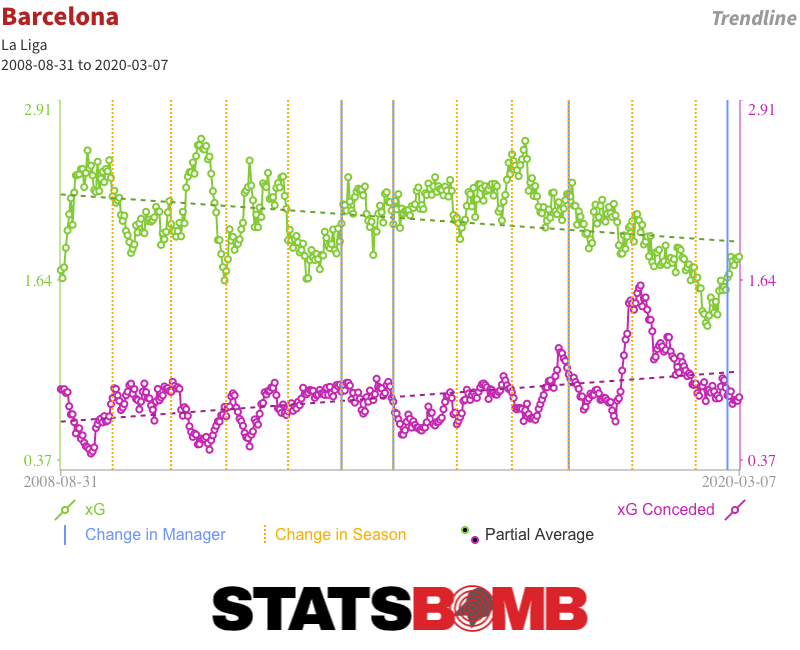
This choice by manager Ernesto Valverde is reasonable. Barcelona’s squad is old. It’s understandable that the club is looking to maximize the last years of a legendary group of players, but for everybody outside of Messi (and arguably Gerard Pique) the cracks are showing.
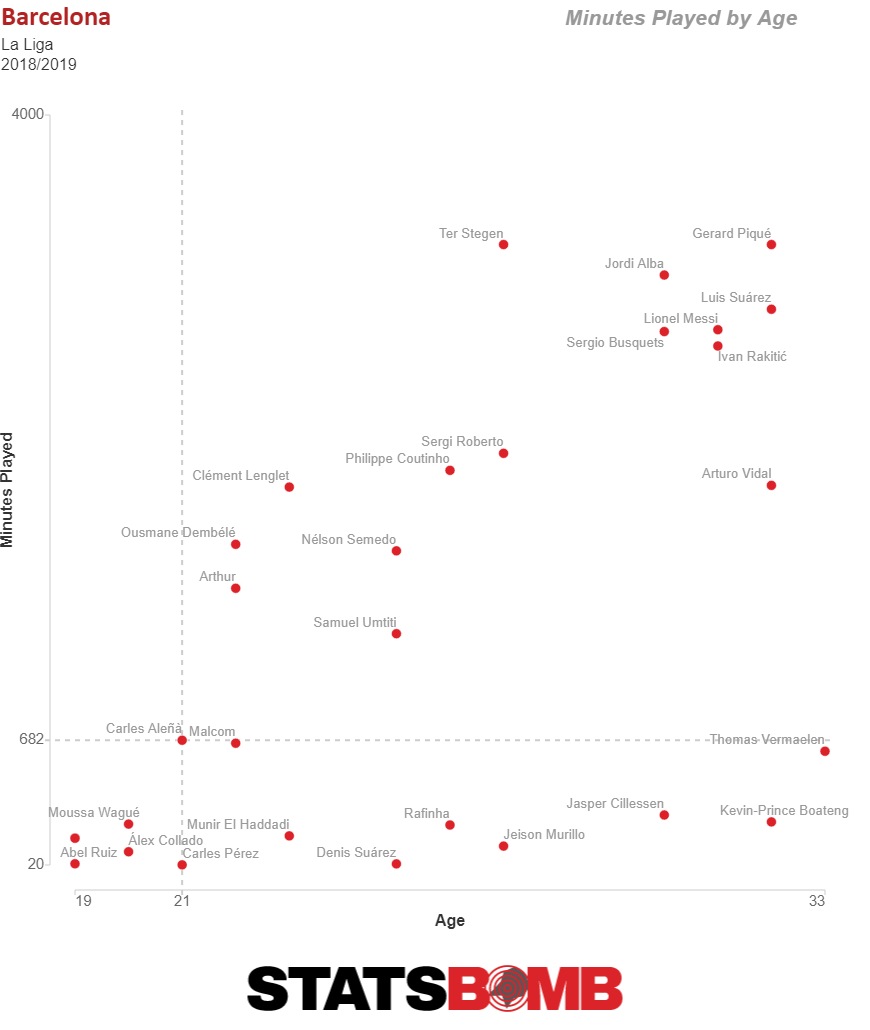
Sergio Busquets and Ivan Rakitic both have noticeably less range than they used to. This has meant that Barcelona, in order to maintain their defensive presence, has had to carry a third midfielder who is more attentive to doing the work of an actual midfielder.
Executing that approach led to more Arthur and Arturo Vidal and sometimes, especially in big matches, Sergi Roberto being repurposed as a nominal wide midfielder pinching inside to further protect the center of the pitch. And while that approach worked, it had deleterious knock-on effects. With so much emphasis on protecting the center of the pitch, Barcelona’s midfielders were less able to influence the attack. Virtually nobody playing outside of the attacking three generated any shots.
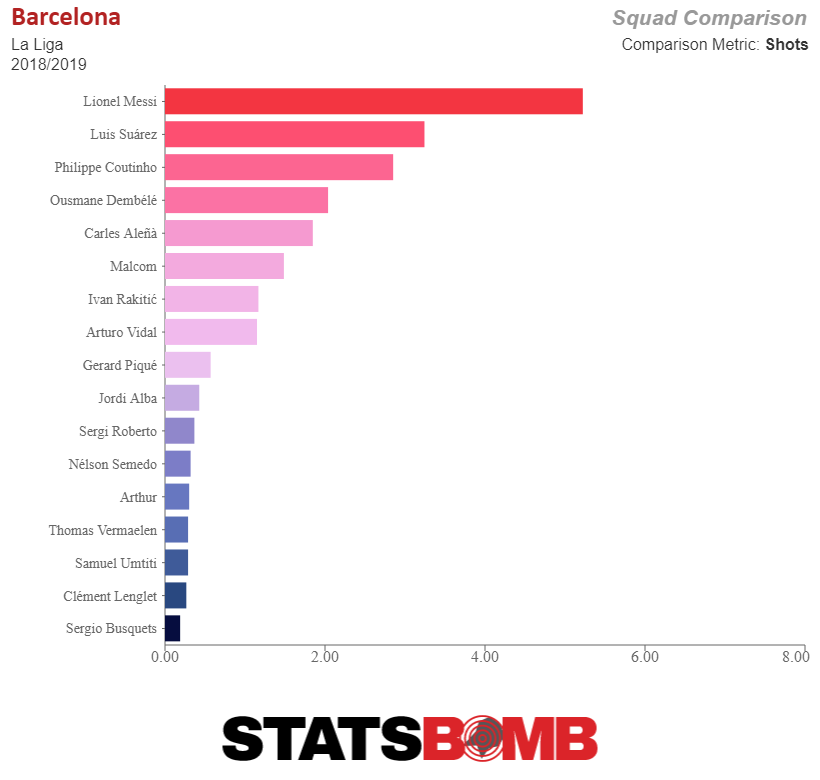
It also meant that Philippe Coutinho who was acquired 18 months ago to fill the great Andres Iniesta’s shoes, suddenly found himself on a team that didn’t have room to carry the kind of midfielder who thrives on attacking possession. Coutinho might have succeeded as a player who got to control the ball with three attackers moving dynamically in front of him, but since he didn’t have the defensive presence to play alongside the slowing Rakitic and Busquets, he never got the chance.
Instead Coutinho played most of his minutes as part of a front three where Messi dominated all the possession duties. Coutinho does a lot of things well, but most of them involve starting with the ball at his feet. Barcelona desperately needed another attacker who thrived moving ahead of Messi without the ball, and Coutinho is simply not that player. The problem was that Ousmane Dembele never stayed healthy enough to become that player, and Malcom wasn’t trusted enough to even be given the chance. And with Luis Suarez slowing down, Lionel Messi did everything.
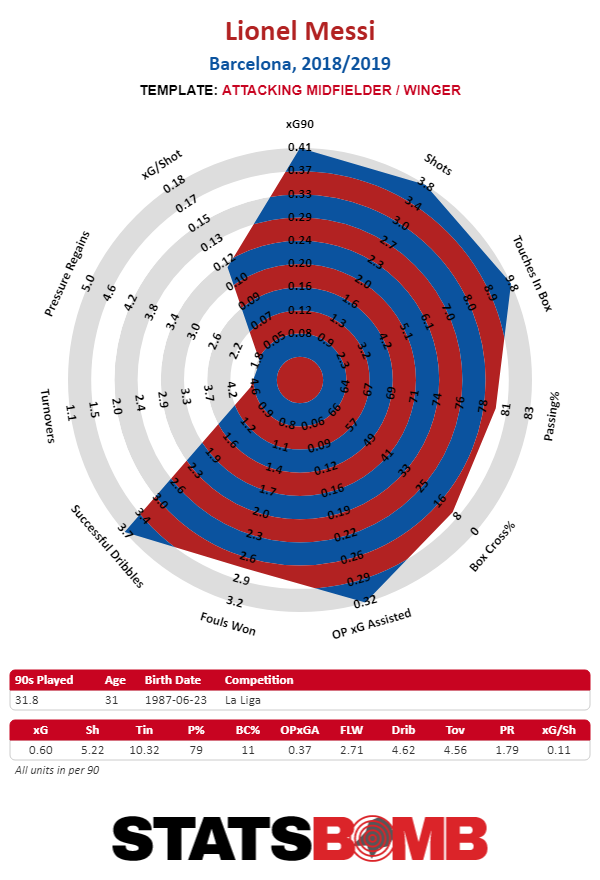
None of these decisions are bad.
Having Messi in the side offers and obvious and easy way for a manager to cover for the sins of a squad that was otherwise surprisingly limited. But, it’s also not the way forward. As Suarez and Busquets and Rakitic and even Pique and Jordi Alba get older, those crevasses are only going to get bigger, the gaps will get harder to fill, and eventually even Messi, who is himself aging (one assumes anyway, though at this point even his actual mortality is in question), won’t be able to fill those holes.
The good news is that help is on the way. Ajax’s Frenkie de Jong might as well have been constructed in a lab to fix Barcelona’s midfield shortcomings. He combines elite defensive mobility with excellent ball progression skills. He's already a Barcelona player. Coutinho ultimately failed because he was a mix of progressive passing and final third presence, while de Jong takes the passing that Coutinho would have provided and combines it with defensive presence rather than a focus attacking contributions. Similarly, in attack, the long-rumored Antoine Griezmann move may finally be happening. He’d bring the ability to either spell Suarez or play alongside Suarez and Messi. And even if that deal for the Atletico Madrid want-away doesn’t materialize, the interest indicates a recognition on Barcelona’s part that something needs to be done to better customize the front three, and in a major way.
A starting eleven which just plugs in de Jong and Griezmann puts the talent on the field to fix the major problems. But, just because the talent will be there to solve the problem doesn’t mean the problem will automatically become solved. And that’s where we come to the question of Valverde. From the outside it’s impossible to know whether his managerial decisions over the last two years were pragmatic choices which reflect the limitations of the squad at his disposal, or the reflection of a fundamental conservatism which he’d seek to implement regardless of the tools he has to work with. It’s also unclear if Valverde, even if he were retained, would have the juice behind the scenes to carry out the changes that need to be made. Featuring de Jong (and Arthur and even Carles Aleñà) means, to some degree, marginalizing Busquets and Rakitic.
The same is true of Griezmann (or whoever) in attack. But, if Valverde returns it’s almost certainly in part because he has strong relationships with the very players he’d then need to start phasing out. That’s not an impossible challenge to overcome, it’s the kind of thing the best managers in the world handle regularly, it’s also the kind of hurdle that trips up lesser leaders all the time. It’s unfair to lay two shock Champions League defeats solely at Valverde’s feet, but even after sharing the blame around it still makes sense to ask if he’s the right man for the job going forward. Barcelona have been linked to a whole host of names, including some of the expected ones like Massimiliano Allegri, some ambitious ones like Erik ten Hag and some, idiosyncratic ones like Roberto Martinez.
Given that the way for Barcelona to improve is for the team to play stylistically differently and use different players than they have over the past two seasons it makes sense to kick a lot of tires. Ultimately the story of Barcelona’s season is that of a manager who adopted a strategy that was good enough to cover for the fact that he had an aging team on his hands that was getting worse in notable ways. That approach won the league, but led to failures elsewhere.
It was an approach that made sense, but it won’t make sense for much longer. If Barcelona keep their manager he’s going to have to change his ways next season to get the most out of a new generation of talent, rather than the old one. If Barcelona determine that he won’t or can’t do that then it’s time to hand over the reins to somebody who will.
Chelsea Season Review: Moving to Stand Still
Chelsea’s season was certainly full of sound and fury, but in the end it signified, mild, and possibly fleeting, improvement.
It was always going to be a year of transition for Chelsea, although at this point the more cynical supporters at Stamford Bridge might suggest, “aren’t they all?” The transition from Antonio Conte to Maurizio Sarri certainly seemed like a dramatic one. Conte emphasized and organized defensive structure while Sarri believes in always always always having the ball.
And the team did change. They went from playing 55% of the passes under Conte to 63% under Sarri. Under Conte the team didn’t care much for building from the back, the average length of a goal kick was 38.39 yards, under Sarri that dropped dramatically to 31.90. On the defensive side of the ball, they went from this:
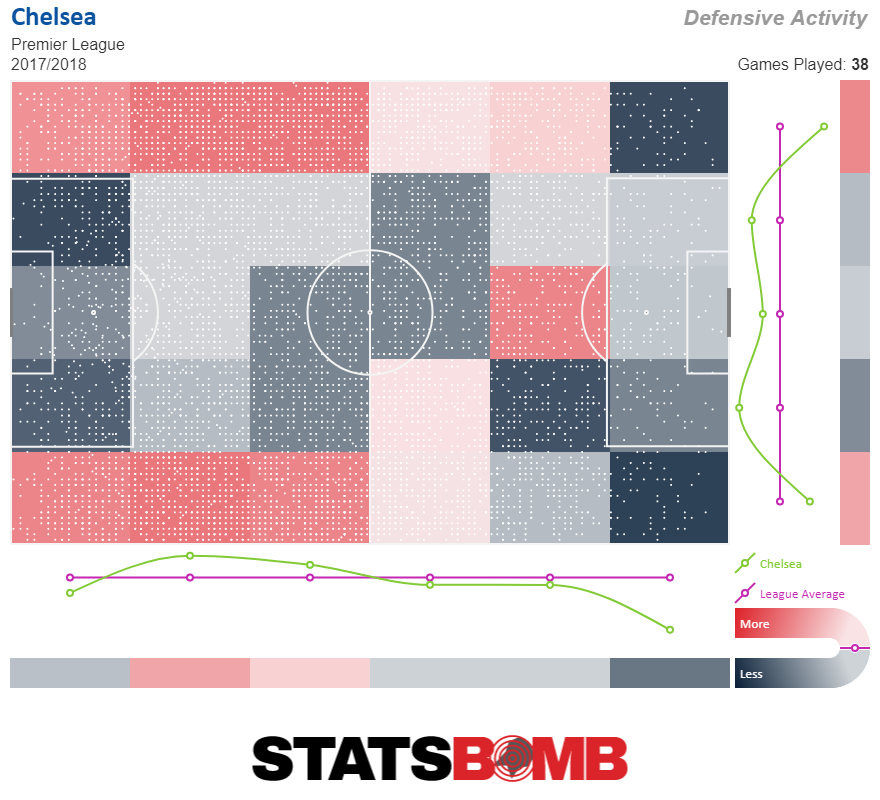
To this:
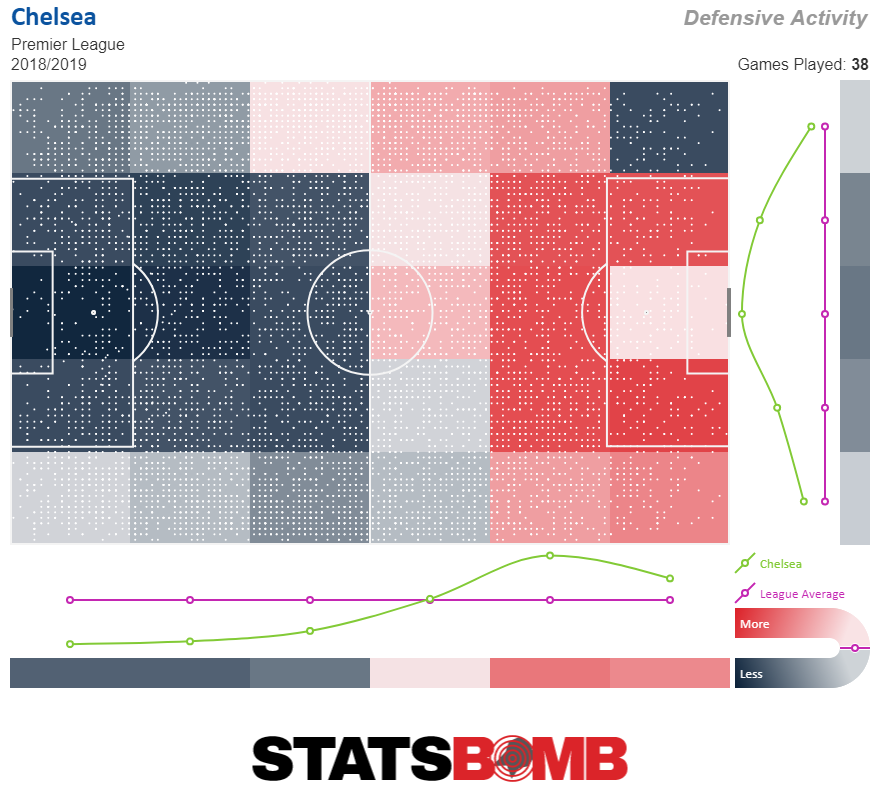
There were real changes in how the team played. But, when you stop looking at how they played, and start looking at the results that those tactical shifts led to, it’s just not clear there was very much improvement. In attack, the possession heavy version of Chelsea actually took fewer shots than Conte’s defensive side, though those shots were on average better, leading to a slight improvement in expected goals scored. Under Conte the team took 604 shots leading to 59 goals and 50.99 xG. This season the goals were virtually the same, but the xG did tick up by about three.
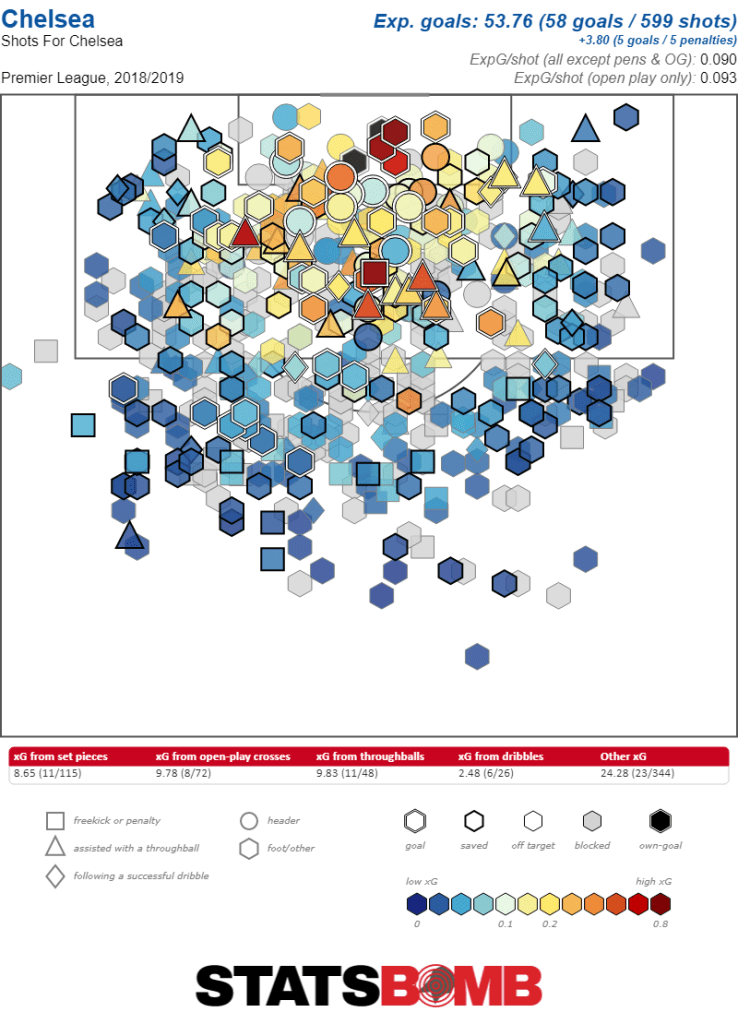
Defensively the story is similarly marginal. They went from conceding 36 non-penalty goals to 38 and their xG conceded went from 31.01 to 32.36. These are relatively small changes which is perfectly in line with their relatively small increase in points from 70 to 72 points. Although that increase proved to crucially be the difference between a fifth place campaign and Europa League rewards and a third place finish and a return to the Champions League.
It feels weird to say Chelsea aren’t very different. Watching them play is a very different experience. Their tactics are clearly very different. Instead of being positionally disciplined they get cut open with ease, but it happens rarely because they have the ball all the time. They frequently spend long passages of play with multiple players working the ball around deep in their opponent’s territory, while last year they attacked quickly and without numbers. But, neither method of attack has proved more fruitful than the other, even if one seems in moments to be more aesthetically pleasing.
Normally this would be a reasonably encouraging first season from a manager. Come in, get the talent that was used to the old system all lined and ready for the new system, improve mildly and lay the groundwork for a big second year. Chelsea’s problem is that this summer is not going to be normal, not in any way shape or form.
For starters, Eden Hazard is, somewhere between possibly and likely, on his way to Real Madrid. He’s 28, and it’s entirely reasonable for Chelsea to listen to offers if Real Madrid back up that money truck, especially if the Belgian is himself set on moving. But, still, it’s going to be hard to replace all that production.
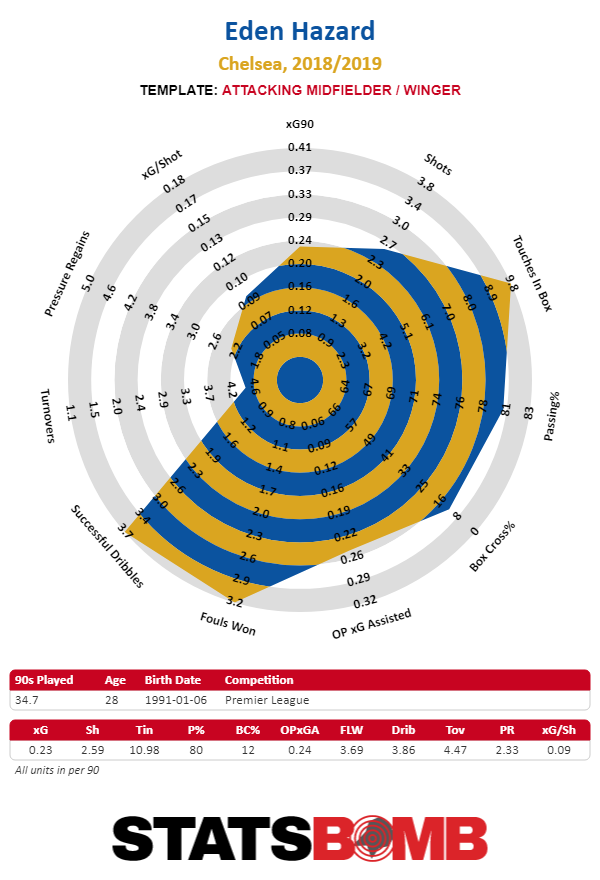
That’s obviously true if Chelsea can’t avoid their looming transfer ban, but even if the ban gets stayed pending appeal, there’s a lot of work to be done. The frontline without Hazard consists of Willian, Pedro and the on loan Gonzalo Higuain, all of whom are on the wrong side of 30. Chrisitian Pulisic will be arriving, and he’s certainly an exciting young wing option, but he’s also not Eden Hazard, even if Chelsea hope he might become the same star level player in a year or three. Callum Hudson-Odoi may or may not be healthy and may or may not be transferring to Bayern Munich. Ruben Loftus-Cheek just suffered a ruptured achilles and the man he replaced in the lineup, Matteo Kovacic may or may not be headed back to Madrid when his loan spell ends. It is not only possible, but likely that only N’Golo Kante and Jorginho are likely to be long term starters on a Sarri side, and while Kante is obviously beyond reproach, there’s a whole lot of reproaching left to do when it comes to Jorginho’s ability to defend in space and the ease with which teams began taking him out of the game by man-marking him.
The case for natural progression and improvement under Sarri rests on increased tactical cohesion going forward. But that case is undercut by the fact that if Hazard leaves then most of the players, especially most of the attacking players, are going to need replacing and upgrading. Now, maybe it’s possible that the new players will be better suited to Sarri’s style (although Kovacic, Higuain and Jorginho were all brought in specifically for the Italian manager), and therefore will take to the system quickly, but even so, as Sarri enters his second year, from a personnel standpoint it’s likely to be as chaotic as his first.
There are, of course, reasons for optimism. In addition to the incoming Pulisic and the injured Loftus-Cheek and Hudson-Odoi there are a number of young talented prospects on the book at Chelsea. Guys like Mason Mount, Tammy Abraham (still), maybe even Michy Batshuayi are possible contributing players in attack. Beyond that, Chelsea have absolutely been willing to spend in recent seasons, and if they aren’t banned it’s reasonable to expect that they will be aggressively looking to add pieces to this team, especially in midfield.
For much of Chelsea’s recent history the relationship between the transfer market and stability has been presented as a binary choice. Either the team can commit to staying the course, keeping their manager, and bringing through young talent, or they can splash the cash in the transfer market. But, given what their squad looks like, that’s no longer a choice. If Hazard goes then the team he leaves behind will both need to spend big and also need to get contributions for it’s handful of developing young players in order to keep moving in the right direction. Only doing one or the other will likely not be enough.
Chelsea had an acceptable season. They made the tiniest of strides in the right direction all while changing the way they played. But, the composition of their roster, and the possibility they’re losing their star means that the second step is going to be harder than the first. In order for Chelsea to progress from a contender for the Champions League places into a Champions League and Premier League contender themselves they’ve got a lot of work to do. That means the kids are going to have to step up and it means that their going to have to add big, impactful pieces this summer. If that happens, they way forward is clear. If not, well all the continuity in the world won’t get them enough points.
Header image courtesy of the Press Association
The Premier League Middle Class is Coming
Over the last couple of weeks on the site we’ve run pieces looking at how Leicester City and Wolverhampton Wanderers might ascend to the heavens of the top tier in the Premier League. The fact that both teams might have credible paths forward is a testament to just how strong the midtable in the Premier League has become.
A quick look at the table shows that behind the elite pairing of Manchester City and Liverpool, the next eight teams in the top half of the table are grouped tightly into two groups of four. Tottenham Hotspur, Chelsea, Arsenal and Manchester United are all between 70 and 65 points. Then there’s a nine point gap down to seventh place Wolves where Wolves, Leicester City, Everton and Watford are all grouped between 54 and 50 points.
That eleven-point gap looms large. It’s a break between tiers in the table that any argument for the improvement of the Premier League middle class has to contend with. Afterall, last year the gap between sixth and seventh was only nine points, with Arsenal finishing the season with 63 points, and Burnley with 54. So has anything really changed?
The answer to that is absolutely yes. For starters, the dynamics of the table are different. Arsenal’s 63 point haul from last season has already been bettered by all of the team upper tier teams this year. It is, at least, possible, that all four of the none elite top six teams will still manage to crack 70 points. The gulf between the top two and the rest is larger than its ever been, but the overall quality of the worst top six team this year, at least by points, is better than last.
So, it’s against that backdrop that we measure the improvements of the middle class. And, here too, we see improvement. Last season the seventh, eight, ninth and tenth spots finished with 54, 49, 47 and 44 points. With two games to go this season those spots are already at 54, 51, 50 and 50. So, the middle class could lose all eight games down the homestretch of the season and still get a better points total in each spot (except for seventh where Wolves would tie Burnley) than similarly situated clubs last year.
As we move deeper into the numbers, the improvements become even more stark. During the 2017-18 season, there were only seven teams with positive xG differential. It was only, surprisingly enough, 11th place Crystal Palace that joined the top six on the positive side of the ledger. The top six dominated the league on both sides of the ball. In attack, the top six teams were the top six teams.
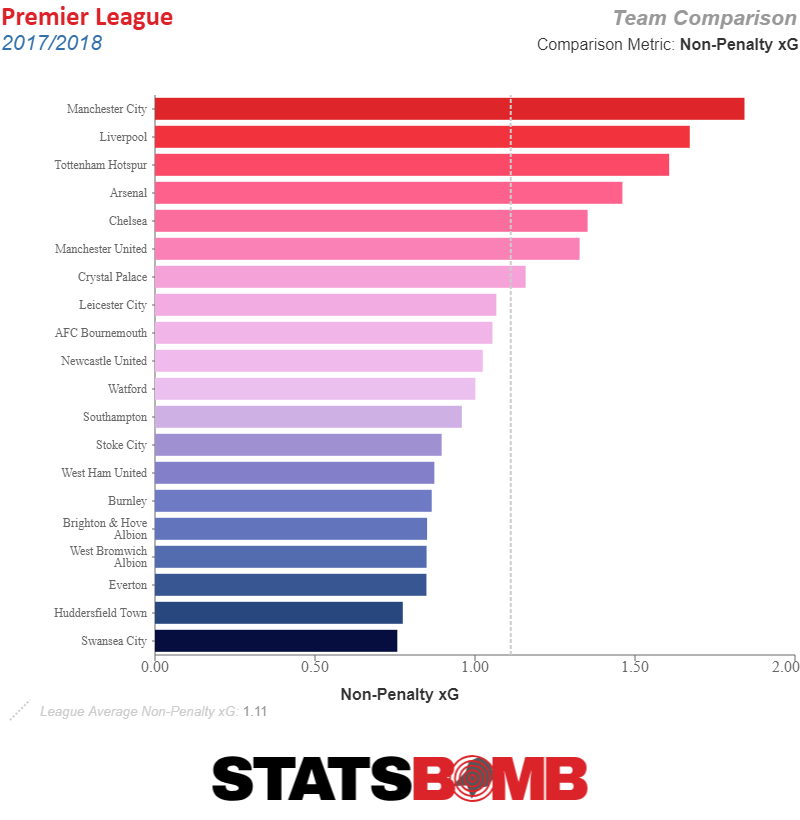
It was only very slightly more varied in defense, where seventh place Burnley managed to sneak ahead of sixth place Arsenal.
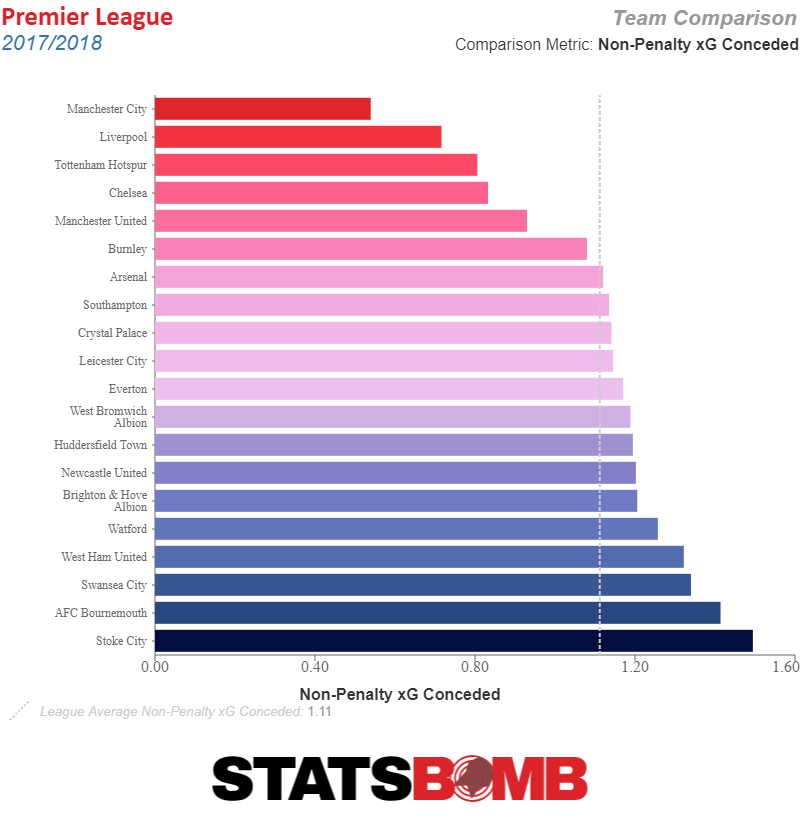
This season is an entirely different story. The entire top nine are in the xG green. Watford, tenth in the table, has recently dropped just below to -0.13 which actually places them with only the twelfth best xG difference in the league. Last season that number would have been the ninth best. Even more amazingly, Wolves and Leicester, in seventh and eighth, actually have better xG differences than Arsenal and United in fifth and sixth.
Split things by attack and defense and the lack of separation between the big six and everybody else becomes even more apparent. While the big six retain their stranglehold on the top attacking size, the difference between them and everybody else has lessened dramatically.
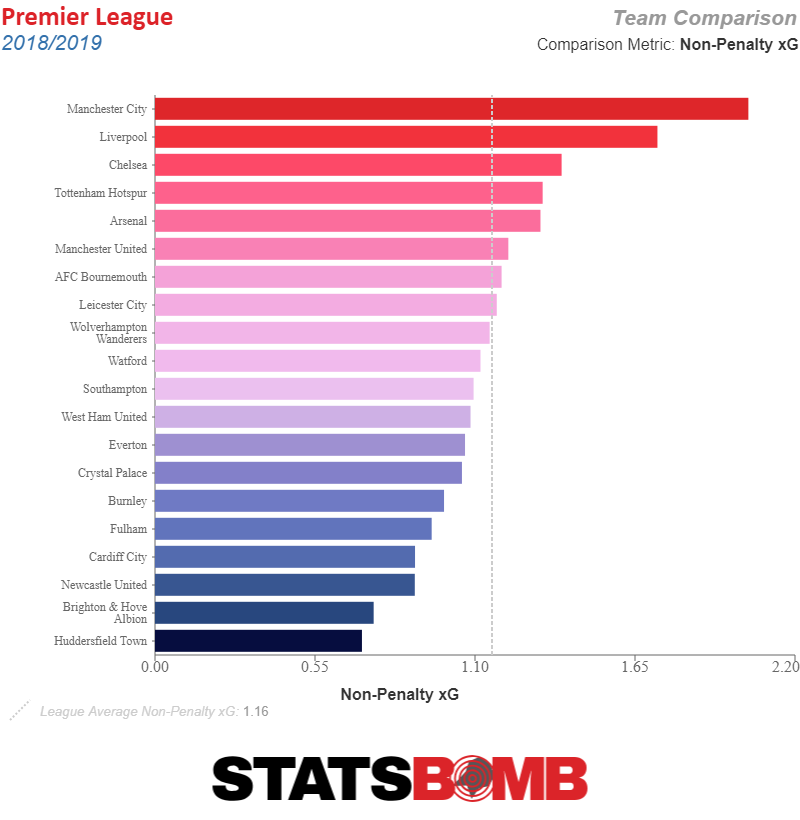
And on the defensive side of the ball. Well, you’d really be hard pressed to see a big six at all.
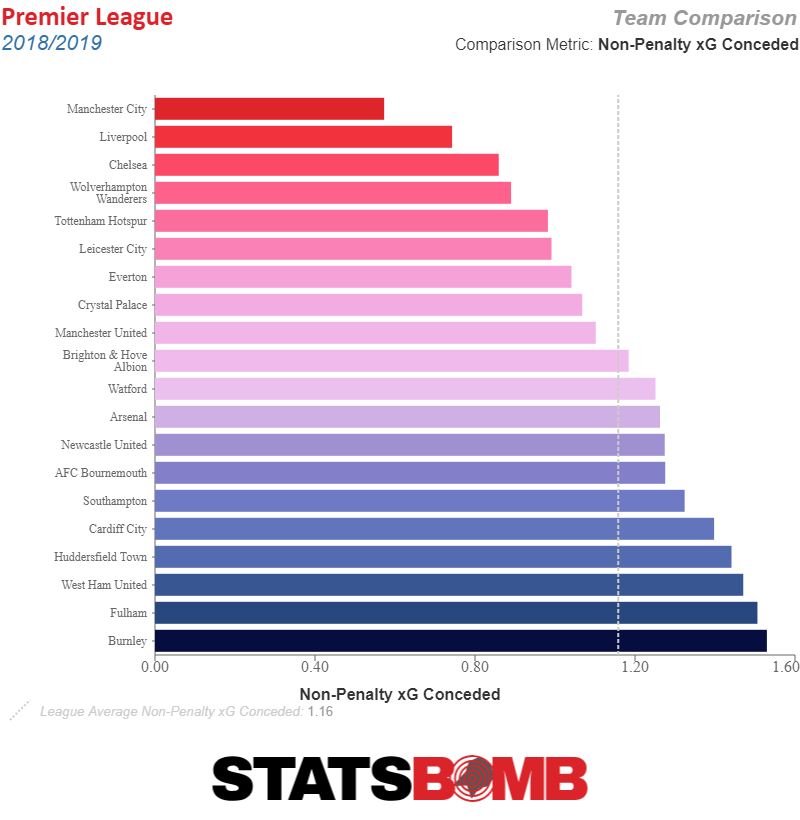
Last season the gap between sixth and seventh was representative of a large gulf in class between teams. This season, the same gap seems to come from a confluence of unlikely results. Take away the unlikely Arsenal winning streak from the beginning of the season, or the Manchester United new manager miracle, or the unlikely string of defeats that cost Claude Puel his job at Leicester, and the table looks very very different indeed.
The interesting question is what happens next? Part of the reasons the top teams are the top teams, and that money is a predictor of success, is that the normal course of events would be for the upstart squads to get raided for talent. Arsenal and United are in desperate need of center backs, and Watford, and Leicester City have tons. Chelsea need a creative attacker and Wolves’ Diogo Jota or Everton’s Richarlison would clearly fit the bill. At fullback, Matt Doherty would make an appealing option for United as well. The list goes on and on.
The talent of upstart Southampton gets turned into the supporting cast of Liverpool. Mikel Arteta goes from Everton’s star, to Arsenal’s conductor. Leicester win the league and their midfield goes to Chelsea and their star winger later heads to Manchester City. When the middle class takes a step forward, the richest clubs buy their shoes, and leave them standing two steps back, and the natural order reasserts itself. That’s how the world has always worked.
It’s not clear if that’s what’s going to happen this summer though. Chelsea still have the specter of a travel ban looming over them. Arsenal are rumored to have financial constraints (though perhaps qualifying for the Champions League by either the top four, or Europa League route could lessen them). Spurs have not spent money in forever, and while the opening of their new stadium means they might be back in the market, they could also conceivably lose Christian Eriksen in addition to Toby Alderweireld meaning they’d have to contemplate climbing out of the hole those players would leave before even beginning to consider improvements. Only Manchester United seem likely to splash cash, but for various reasons commercial and otherwise they have always seemed more interested in shiny objects like Jadon Sancho, than the more meat and potato possibilities closer to home.
Meanwhile Everton’s ownership show no signs of decreasing their spending. The Wolves project (or whatever more pejorative term you might like to use for it) has both money to burn, and an incentive to reach for the Champions League stars. And while Leicester City spent last summer selling Riyad Mahrez, they also spent it not selling Harry Maguire. It’s not hard to envision a transfer window where the middle class teams spent months effectively improving their clubs, while the sides above them struggle to do the same. If that turns out to be the case then next season will truly be a different world.
Despite what a cursory look at the table might tell you, this season has definitely seen an improvement for those teams chasing the top six. That’s not all that remarkable by itself. But, if that improvement continues, then what happens next could get very very interesting.
Header image courtesy of the Press Association
Can Wolves Leave the Chasing Pack and Join the Premier League's Big Six?
The case that Wolverhampton Wanderers are the seventh best team in the Premier League is an easy one to make. They’re seventh in the table, you don’t get a better intuitive starting point than that. The question, as they look towards next season is, how much better can they become?
There’s an interesting dichotomy to Wolves results. When they go toe to toe with England’s biggest clubs they are consistently able to put up big results. At the same time, the gap between Manchester United in sixth and Wolves in seventh is a massive 13 points. Wolves recent history backs this up. Over their last six matches they’ve taken a whopping seven points from big six sides, with home wins against both Arsenal and Manchester United as well as a draw against Chelsea at Stamford Bridge. But, in their other three matches they took a grand total of a single point, losing away to Burnley and Southampton while drawing at home against Brighton and Hove Albion.
The results seem to suggest that Wolves are a team built on a very strong defense, but one that has trouble transitioning into attack against weaker sides. The numbers, at least to a certain, extent back this up. The top six have spent the season absolutely beating up on everybody else. Looking at expected goals per match against only the bottom 14 teams, there’s a real gap between them and the top six. They’re still the seventh best team when it comes to scoring on the best of the rest, but if they want to be on par with the best sides, they’ve got work to do.
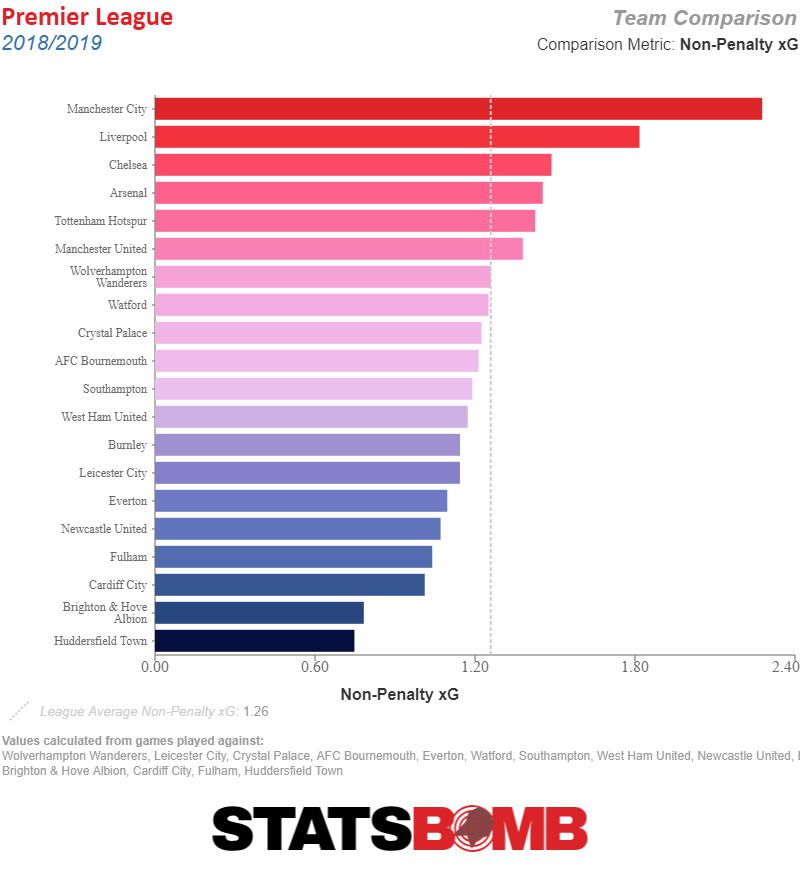
Against good teams, Wolves can leverage their defense into creating counterattacking opportunities. They’re so good at absorbing pressure that they can invite teams onto them, and then attack into space using only three or four players. But, against everybody else, Wolves are left having to create their own space. They’re great at exploiting the holes teams give them, they’re less strong when they need to break through the wall themselves.
Theoretically speaking there are two ways to deal with a committed defense. Either ramp up the number of shots, a strategy that can be combined with remaining structurally sound defensively, or ramp up the positional risk taking to try and create great shots despite the number of players committed to stopping the attack (or be Manchester City and do both). Wolves do neither.
Against fellow teams in the bottom Wolves take just under 14 shots per match. That’s eighth best in the league.
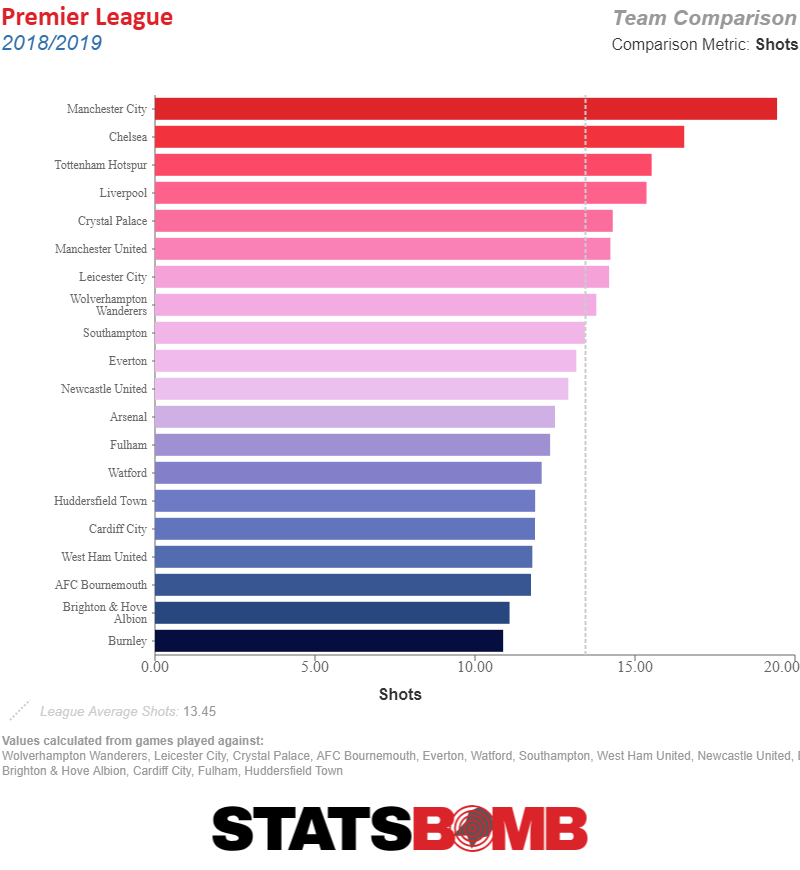
That’s a fine number, and with the sides stellar defense it’s absolutely enough to keep them right there competing for the best of the rest, probably going to qualify for Europa League trophy. It would even be enough to push them towards the top six if they were augmenting it by taking great shots. The problem is, they aren’t.
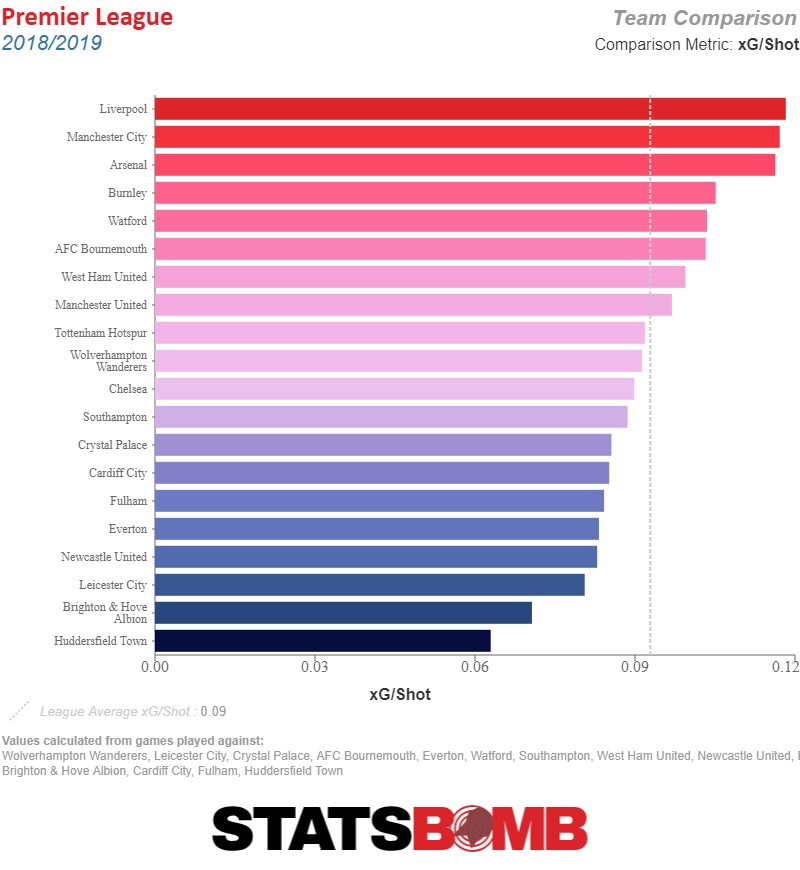
Looking at the two tables makes the challenge ahead for Wolves crystal clear. If they want to run with the big boys they’re going to need to do something to juice up their attack against everybody else. Chelsea piles on the shots, Arsenal and Liverpool commit to getting high quality looks (Arsenal by sacrificing their defense and Liverpool by being awesome). City do both. Manchester United and Spurs aren’t quite as extreme, but rather are somewhat better than Wolves in both departments.
It should be possible for Wolves to overcome that challenge. This team, after all, didn’t simply defend their way to promotion. In the Championship they were a juggernaut on both sides of the ball. There are essentially two ways they might approach the problem, one is tactical and one is personnel. Or, possibly more likely, they’ll look to do both.
First, they could just continue to play exactly the same way but upgrade some of their players. In attack Wolves rely on their front two of Raul Jimenez and Diogo Jota to do the majority of the work, supported first by right wingback Matt Doherty, and then by midfielder Leander Dendoncker from midfield. Dendoncker’s midfield partners rarely get forward, and the left wingback is consistently more conservative than the attack first Doherty. Either upgrading Dendoncker (who is himself technically on loan from Anderlecht) to a more complete and dynamic midfield option, or doing the same at left wingback, might boost the attack all by itself. Wolves will need to add depth to their thing squad anyway, and adding pieces at the top of the depth chart might solve the attacking dynamism problem.
Secondly, they could loosen the tactical shackles they’ve placed on themselves. A little less focus on their defensive structure might make their defensive structure slightly less sound, but allowing a non-Dendoncker midfielder to get forward from time to time would likely more than make up for it. It’s possible that this will happen naturally. This is, after all, Wolves first season in the top flight. It was reasonable for them to treat away matches against pretty much everybody as affairs to be approached cautiously. Next season, with higher expectations, the team should be less interested in approaching matches from a defense first, happy just to get a draw approach. That doesn’t mean they should go hog wild and starting throwing eight men forward, but that they should be more willing to try and ratchet up pressure in more situations.
Those two options feed off each other. If they upgrade their talent either in central defense or midfield, it’s possible they might be able to play a somewhat more expansive game without sacrificing the superior defense that’s gotten them to this point. What Wolves can’t do is invest in talent that would allow them to play more expansively while not giving them the freedom to do so. That’s how you waste money and tread water, rather than continuing what has been a meteoric climb.
The exciting thing for Wolves is that their recent history suggests they have the capability to ratchet up the attacking intent if they choose to do so. It’s understandable that they didn’t this season. Next season there’s at least a chance they could build the squad that supports that approach. And if they do, there’s no reason they couldn’t close the gap to the top six, and with a couple of breaks, join the upper tier of the Premier League themselves.
Obviously Mohamed Salah Should Have Been on the PFA Shortlist
It doesn’t take advanced statistics to understand how absurd Mohamed Salah not even being shortlisted for the Professional Football Association men’s Player of the Year award is. Six players make the list, and there’s a case to be made that Salah is more deserving than five of them.
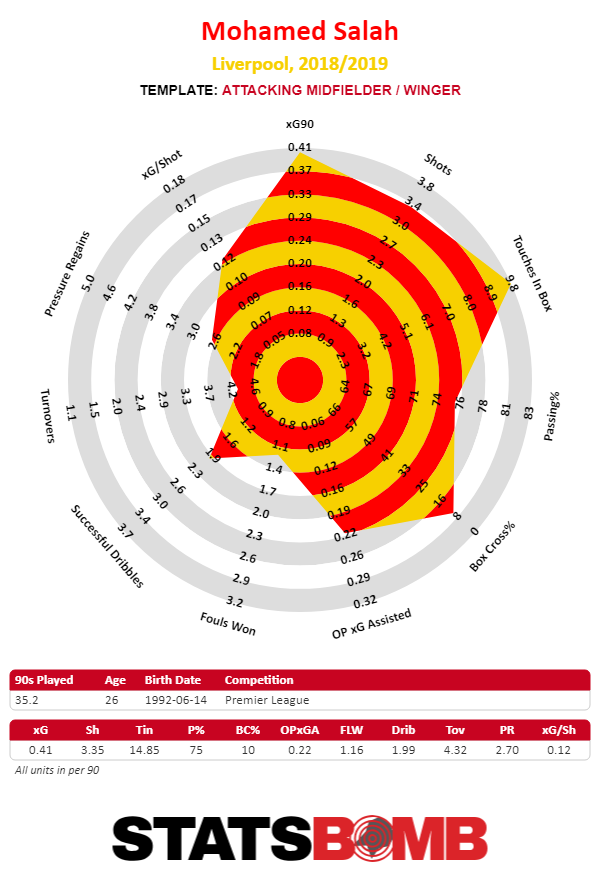
Let’s start by taking Salah’s teammate, defender Virgil van Dijk off the table. Van Dijk is an imposing granite statue given magical life and mystical defensive powers beyond our ken. Nobody particularly disputes that he’s the best defender in the Premier League, and since it’s impossible to compare defenders to attackers anyway, let’s assume he deserves to be there, quite possibly deserves to win the award, and that there’s no real reason to think otherwise.
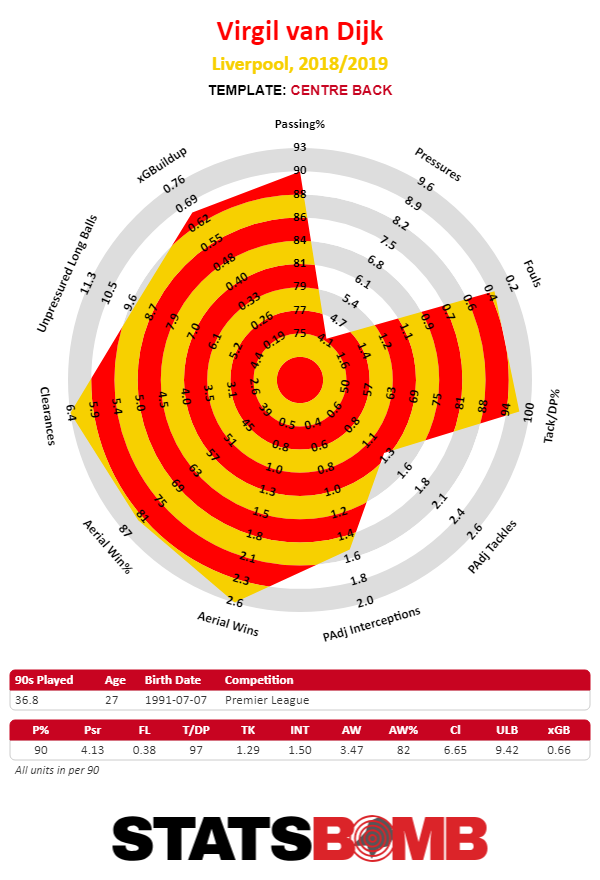
Everybody else on the other hand, well, let’s break it down. There were five phenomenal attackers nominated for the award. Sergio Aguero, Raheem Sterling, Bernardo Silva, Sadio Mane and Eden Hazard are all great. Its not clear that any of them are having a better year than Salah though.
Ageuro and Sterling are probably the two with the most impressive resumes. Aguero’s 19 goals are tied for the league lead with, you guessed it, Salah. And, to Aguero’s credit, he’s scored only two penalty goals while Salah has scored three, and he’s run up the goal total in less minutes, 2221 than Salah’s 3169. The assists tell a similar story, Aguero has eight and Salah has seven. Both impressive numbers to go alongside their goal scoring, Aguero’s more impressive, given the shorter minutes.
It’s worth noting here that Salah’s expected goals assisted per 90 tally is actually significantly higher than Aguero’s, 0.23 to 0.15. There are good reasons to not use xG when looking at end of the year awards. The metric is great at predicting what will happen, and how players that overperform will eventually come back to earth, but awards are backwards looking, not forwards looking. It seems both right and appropriate to award a player credit for having a great finishing season. But, assists are a slightly different matter. A player with a lot of assists, but with a relatively low xG assisted is, more or less, getting rewarded for his teammates’ finishing. At some point, the topline numbers are the topline numbers, but when it comes to passing it’s at least worth considering what’s going on under the hood.
Regardless, while you might make the case that Salah’s season is as good as Aguero’s it’s certainly not clearly better.
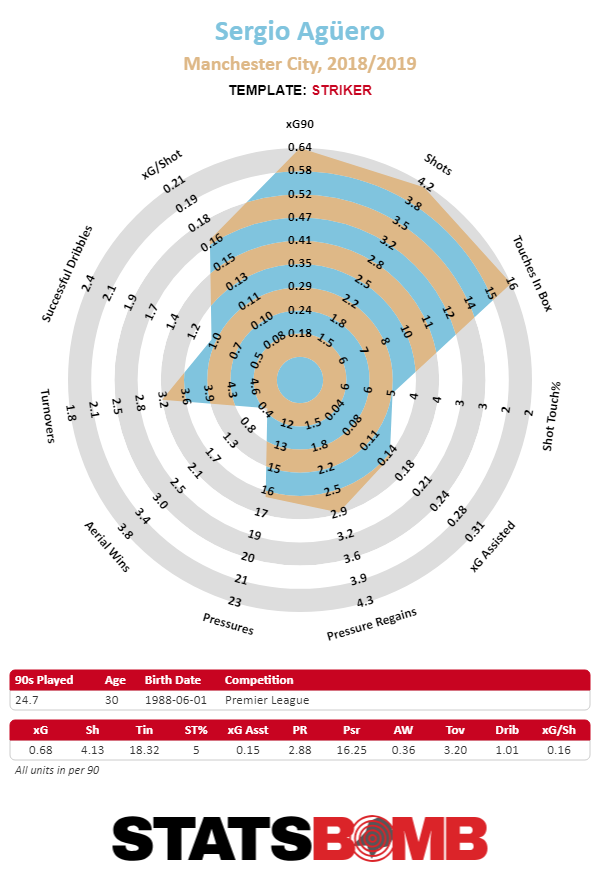
The same is true of Aguero’s teammate, Raheem Sterling. Sterling is having an amazing season. His goal scoring is based on some incredibly strong finishing, he’s averaging 0.60 non-penalty goals per 90 minutes, and “only” 0.40 xG per 90. Either he magically learned how to kick the ball last summer while he was in Russia, or finishing is itself a noisy skill that often times is divorced from talent level, and the arguments that he lacked the ability to finish before this season were greatly exaggerated.
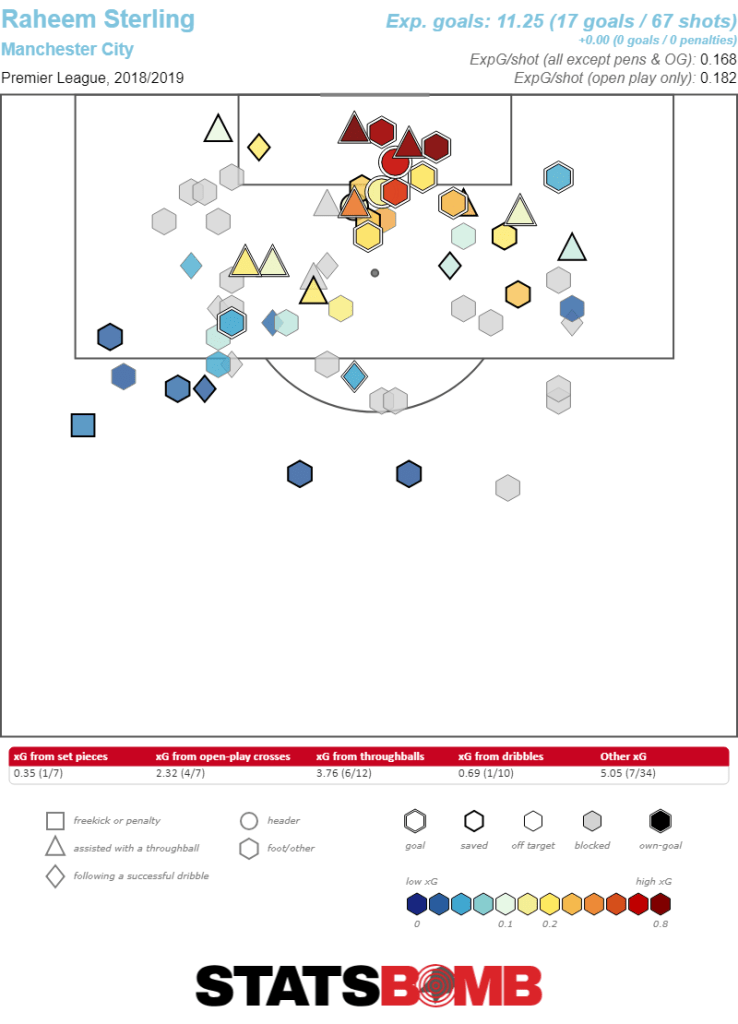
But, incredible as it seems to say about a man with 17 goals, it’s his passing that sets him apart from everybody else. His nine assists leave him tied for fifth in the Premier League, but he’s gotten those without the benefit of his teammates excelling at finishing his passes. He leads the league in xG assisted per 90 with an eye watering 0.35. There are only two other players in England that have played 1000 minutes and cleared 0.30 and they happen to be his teammates Leroy Sane and David Silva. If you want to make the case for the best attacking passer in this season’s Premier League, Sterling might be your guy. Combine that passing with a great finishing year, and again it’s hard to argue that Salah is having a better season than Sterling. Aguero and Sterling are the only two players with combined goals and assists per 90 that are higher than 0.90, hard to see how they should be here.
And this is where things start to get interesting. Eden Hazard’s major claim to this list is his creative ability. His 16 goals are a lot, but a fully quarter of them are penalties. His non-penalty goals per 90 rate of 0.37 is below Salah’s 0.45. Of course, Hazard makes up for that in the assist department where he has a league leading 13. But, while his assist total far outstrips the Egyptian’s he only assists 0.03 more xG per match. In effect the reason Hazard is on this list and Salah is not is that his teammates have done a better job finishing his passes than Salah’s have.
Of course, things are never that cut and dry. Hazard has been performing on a team which isn’t nearly as good as Salah. He is often asked to shoulder all the attacking creativity himself, while Salah gets to share it across the frontline. In fact, Hazard is the only player not from one of the top two teams on this list. Great team effects are a thing, and it’s easier to rack up the assists if you’ve got another top player or two to interact with. The argument for Hazard is that if the attackers swapped teams, Hazard’s numbers would go up and Salah’s would go down, demonstrating that in fact putting up lesser numbers on the poorer team is the greater achievement. It’s not a bad case, even if it is ultimately a theoretical argument that’s impossible to prove.
That argument isn’t available to Salah’s teammate, Sadio Mané. Mané has exactly one thing going for him. He’s scored 18 goals, none of them penalties. His non-penalty goal scoring rate of 0.55 is higher than Salah’s 0.45. Salah is better at literally everything else. Mané only has one assist, and his xG assisted rate of 0.15 is lower than Salah’s. And hey, scoring goals, non-penalty ones even, is important, but it’s not the only thing an attacker does (and if it was, well, Pierre-Emerick Aubameyang has scored more total goals and at exactly the same rate for non-penalty goals and he didn’t make the list). It’s just hard to find a real reason to include Mané over Salah that doesn’t amount to getting bored with last year’s winner and casting around for some new blood.
And that’s before we even get to Bernardo Silva. City’s younger Silva is a wonderful player. He has also scored a grand total of six goals and assisted on seven. His creative output isn’t higher than Salah’s, and it’s not a result of his teammates’ finishing either, his xG assisted per 90 is 0.21, higher than Mané’s but lower than every other attacker on this list. The case for Silva over Salah would primarily be a defensive one. Silva is truly a wonderful presser of the ball, and since he often plays as somewhat more of a midfielder than an attacker, it’s understandable that his attacking numbers are a little bit lower. And looking at their radars side by side it’s clear that Salah and Silva really do completely different things.
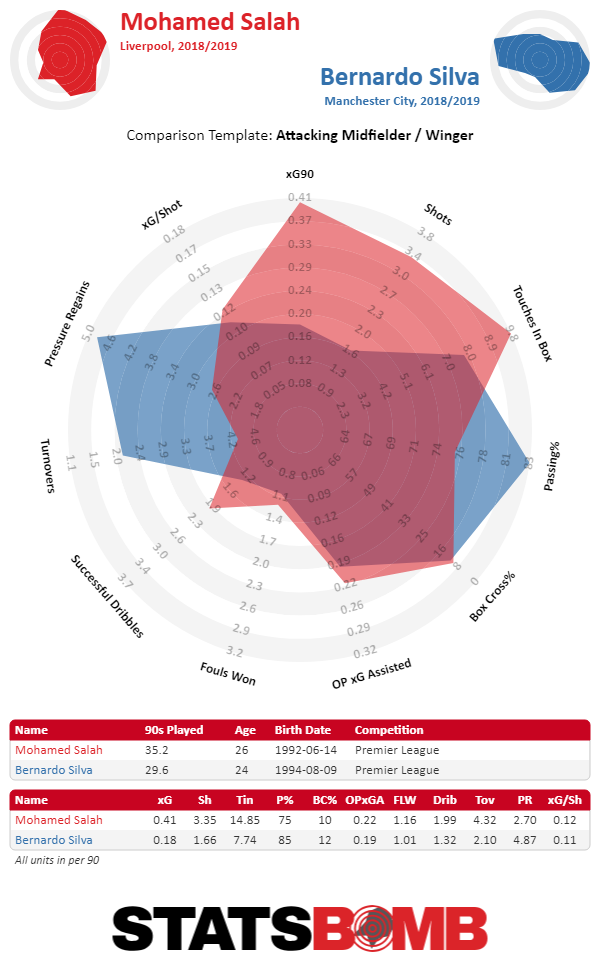
But, even so, it’s just hard to wrap your brain around Bernardo Silva being on this list because he’s a good pressing midfielder. He’s not even the most important midfielder on Manchester City when it comes to defensive contribution, that’s Fernandinho. In fact, Fernandinho would have a larger claim to this list than Silva, and it would be easier to make the case for him over Salah than it is for the all around game of Silva. Silva is a very good player, and he’s had an excellent season, but it pales in comparison to Salah.
Ultimately awards are silly. They exist only so we can argue about them and players can feel slighted by not receiving them and thus fuel their emotional and competitive fires. But, even understanding that, it takes some extreme mental gymnastics to make a list for player of the year that leaves off last year’s winner, especially given that he’s currently the joint top joint goal scorer in the Premier League. In the grand scheme of things it doesn’t really matter that the PFA made a bizarre decision to leave Salah off this list, but that doesn’t make it any more right.
Header image courtesy of the Press Association
Riding Marco Silva's Everton Rollercoaster
You’re never as good as you look when you win, or as bad as you look when you lose. It’s a quote that’s been ascribed to a number of different coaches over the years, and a sentiment that all coaches, across all sports, almost assuredly share. And Everton are a walking, talking, currently playing out of their minds example.
Everton are flying high right now. They’ve recorded three strong wins in a row. The streak has taken them to 46 points (almost 20% of the teams points this season have come in the last three matches), tied with Watford one point behind Leicester City and Wolves for seventh place (although Wolves and Watford have a game in hand). For a team that seemed to be falling short of its aspirations for a seventh place, best of the rest season, the last month has seen the dream revived.
The team’s underlying numbers support their case. While their attack has been somewhat underwhelming, 1.06 expected goals per match places them 12th in the league, their defense has been stronger. Marco Silva’s men allow opponents only 1.09 xG, the eighth best total in the league. Put it together and the xG difference of -.03 lands them tenth in the table, or roughly where they currently are.
But, Everton’s season has not been steady. It’s been a rollercoaster of ups and downs. The nine points from the last three matches are only slightly less than the ten points the team took from the 11 matches before that. The first thing to check in a situation like this is to wonder if perhaps the team’s level of performance has stayed constant, but their luck has drastically shifted. Maybe they were playing fine for 11 games but had sinned in some way in the eyes of the soccer gods and were enduring punishments meted out by the fates. Or, maybe it’s the other way around and Everton’s performances remain bad, but after ten games of suffering the gods relented and rewarded them with ill-deserved points.
As it turns out, neither of those things are true. Looking at a ten-game rolling average of their xG difference shows a team that’s goal difference hangs pretty consistently around where the model predicts it should be, and if anything they were overperforming even while struggling.
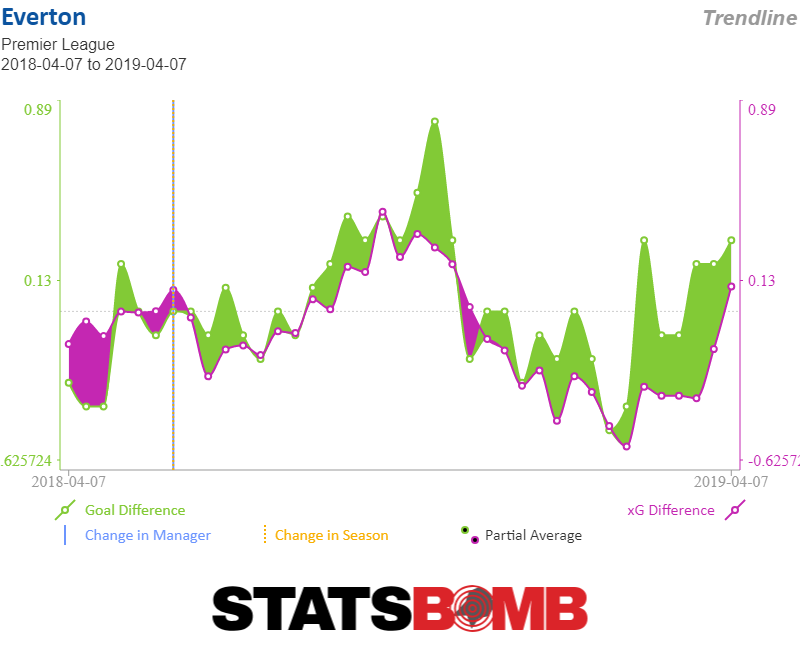
In fact, if we look at the component parts of Everton’s xG difference, it’s clear that there have been real and dramatic changes in their performance level over the course of the season.
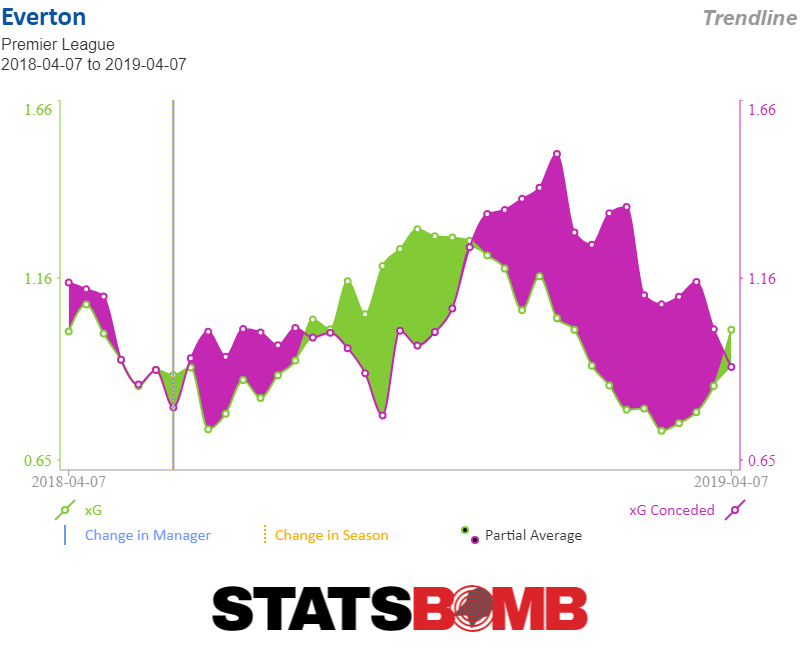
Both the attack and the defense have varied wildly as the season progressed, and fairly faithfully mirrored the side’s results. Early on as Everton played well to start the season, they were a positive xG differential side, then came the dark times, and now, once again, the light.
Clearly this isn’t schedule driven either. Everton’s three wins, and the accompanying strong performances came against Arsenal, Chelsea, and West Ham. It’s certainly true that the tougher two matches were at home, but so were matches they lost against Wolves, and Leicester during their struggle months. And crushing West Ham away from him stacks up pretty favorably against Newcastle, Brighton, Southampton, and Watford, all matches they failed to take even a point from before the switch flipped.
It might be possible to explain away Everton’s swingy performances if they had suffered from a rash of injuries. Maybe for a few months they simply couldn’t put their good players on the field. But, that too isn’t the case. The side has been remarkably healthy and consistent this year. Ten different players have played at least 2000 minutes so far, and two more have cracked the 1500-minute barrier. Silva has a settled side and a couple of preferred substitutes, but for the most part the Everton team is the Everton team, and there’s not a lot of tinkering going on under the hood.
So, how to explain the wild swings? One way is to suggest that perhaps Silva, in his first season is only now, 30 games deep, getting the team to play the way he wants. The early season results were nice, but largely built on the back of a team still throwing off the big shackles of Big Sam Allardyce. They won because they successfully played a more conservative brand of football than Silva wanted. The bad times were just growing pains, as the team slowly transitioned from one style of play to the other. Sure they weren’t playing well but it was all in service of the plan. The plan that is now coming to fruition.
The other option is that there is no particular reason for the swings and roundabouts of the Toffees' season. Sometimes teams play well, and sometimes they play poorly. Variance, good and bad, is part of the game. Everton weren’t as bad as they seemed for those months, aren’t as good as they seem now, and the truth will inevitably work out somewhere in the middle. The good and the bad averages out, and the truth of the team over the course of the season lies somewhere in the middle.
This may seem like an academic argument. What exactly does it matter in the grand scheme of things if Everton are improving or just floating adrift around their average level of performance? Points are points, and at the end of the season that’s all that matters. And that’s certainly true as far as it goes, you don’t get bonus points for moving the right way, or demerits because you got lucky. But, as the season winds down the Everton brass are going to have to make a decision. And that’s not academic.
Everton management are going to look at the season, see the performance and decide whether to keep Silva in charge. And making that decision involves a judgment call. What does the future hold? Is the story of improvement true? If it is then keeping Silva and investing in his vision of the team is a no brainer. If Everton are closer to the team that’s showed up the last three weeks, than the team of the previous three months, than the future is bright indeed. But, if the other story is true, that Everton are both things at once, then the call becomes a lot harder. On the balance of the season Silva has been just ok, but nothing special, on the balance of the last three matches he’s been amazing. The question is which window is telling the fuller picture?
Header image courtesy of the Press Association
Germans Have the Most (Footballing) Fun
It’s been a difficult season, internationally, for Bundesliga clubs. Not a single German team has made it to the quarterfinals of the Champions Leagueand Only Eintracht Frankfurt is still kicking in the Europa League. But, domestically, the league is enjoying its closest title race in years and, perhaps more importantly, the Bundesliga remains a league where the goals go flying in.
German teams, generally speaking, don’t play defense. The top three teams in the league have strong expected goals allowed numbers, with 0.91, 0.63 and 0.86 xG allowed respectively for Borussia Dortmund, Bayern Munich and RB Leipzig, they’re the only three teams in the entire league that have allowed less than 1.2 xG per match. There’s an absolutely gigantic gap, over a third of a goal, between Dortmund, and the fourth best defensive team in the Bundesliga, at least by xG, Wolfsburg.
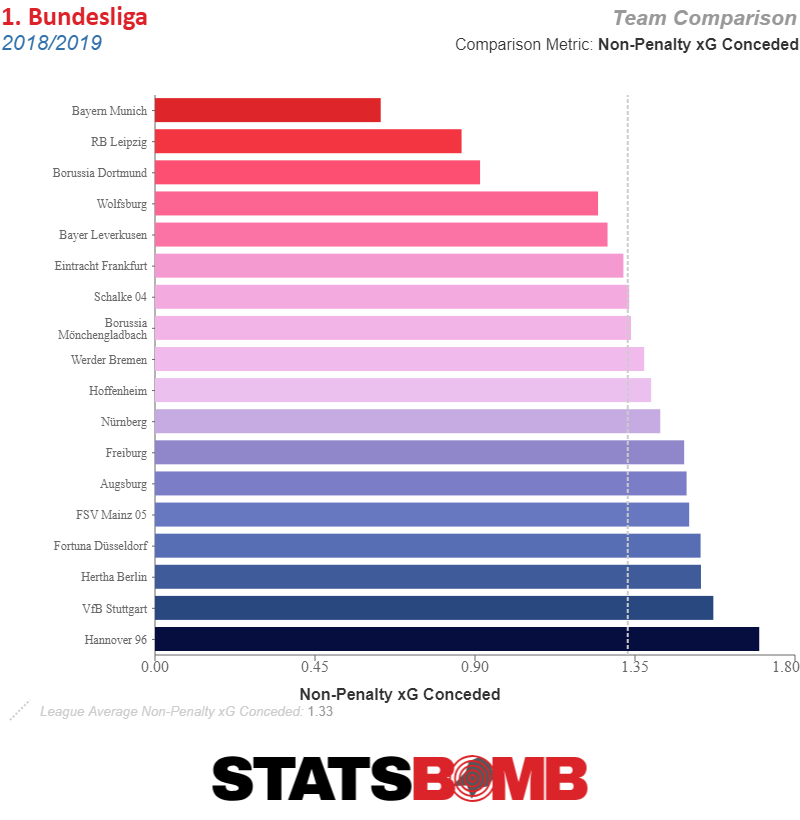
In England, by contrast, a full half of the league allows less than 1.20 xG per match, and Arsenal narrowly miss out, allowing 1.21. It’s a difference that’s easy to miss.
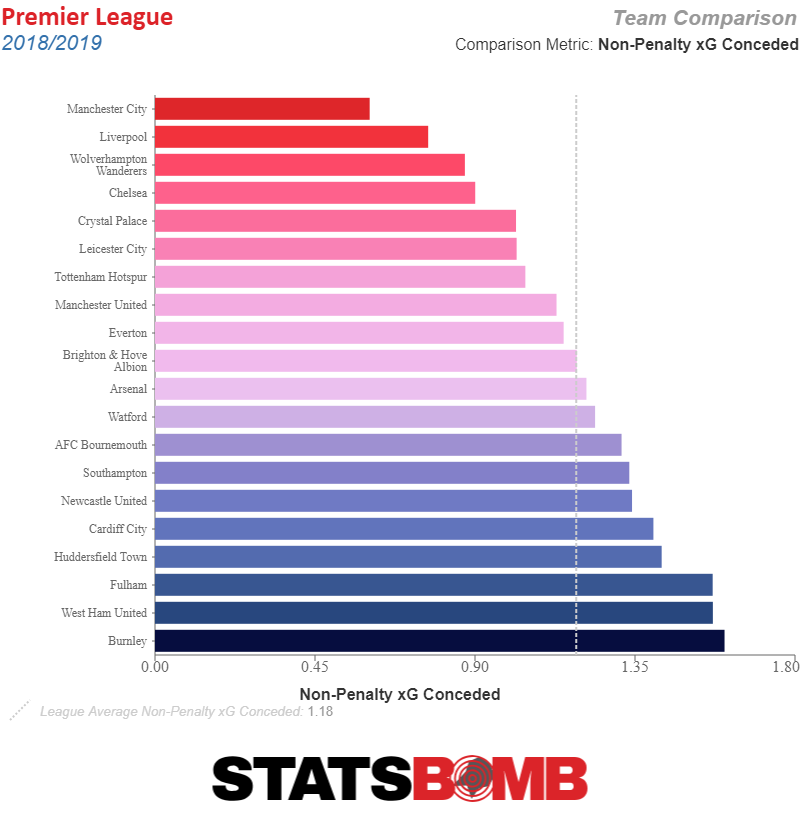
But, England only has one more team that allows less than a single expected goal than Germany, and looking at a round number as a natural cutoff point makes it seem like the two leagues have similar dynamics, each with only a handful of strong defensive teams. But, slide a little further down the ladder and what’s clear is that the average English team is simply much more committed to defending than the average German one.
Unsurprisingly, on the flip side of the ball, Germany teams are more invested in attacking. There are only two German teams that tally less than a single expected goal per match, Nurnberg and Hannover, the two worst teams in the league. The Premier League meanwhile sports five inept attacking teams. It’s helpful to look at those totals as a percentage of the league in order to compare the Premier League’s 20 apples with the Bundesliga’s 18 oranges, and what it amounts to as 25% of the Premier League is inept when attacking while only 11% of the Bundesliga is. If we look at the most attacking teams in the league we find that only the big six in England average more than 1.2 xG per match while in Germany ten teams do. They also happen to be the top ten teams in the table.
There are of course more than two leagues at the top of the European pyramid. But, Italy and Spain tell slightly more complicated stories. Serie A actually looks quite a bit like England. The league has six teams, Juventus, Napoli, Inter Milan, AC Milan, Atalanta and Lazio that allow less than one xG per match and nine that allow less than 1.2. On the attacking side of the ball there are eight teams that rack up more than 1.2 xG per match, and five teams that are below the expected goal line.
England and Italy have similar contours. Both leagues are significantly more defensive than Germany, and they both have a larger group of dominant teams at the top that tick the box on both sides of the ball. In both leagues teams up and down the table demonstrate the ability to defend, while it’s only the elite cadre of clubs that pour on the attacking hot sauce. Despite their reputational differences, and the clear stylistic divergences, both leagues by and large end up at a similar place, one that’s an entire continent away from Germany.
Then there’s Spain. Nobody can score in Spain. There are a whopping eight teams in Spain that average below a single expected goal per match. And while only four teams allow less than one expected goal per match, there are also only three teams in the league that allow more than 1.2. Two teams fall are both allowing more than 1.2 and scoring less than one, Celta Vigo, having a surprisingly poor season and battling relegation in 18th place, and Deportivo Alavés, a team currently in fifth place. Yes, fifth place. Why? How? Sometimes absolutely everything breaks right for a team.
What sets Spain apart from the other three leagues is that the teams in La Liga just refuse to cluster around one side of the ball or the other. In England the six teams at the top of the table are the six best attacking teams, in Germany the three teams at the top of the table are the three best defensive teams. In Italy the six teams at the top of the table are the six best defensive teams. At least, as far as expected goals can tell. In Spain, who the heck knows.
On the defensive side of the ball, the four teams that allow less than a goal, are Atlético Madrid in second, Getafe in fourth, Valencia in seventh and Leganés in 12th. On the attacking side of the ball there are six teams that score more than 1.2 xG per match, they are Barcelona in first, Real Madrid in third, Sevilla in sixth, Valencia in seventh, Eibar in 11th, and Espanyol in 14th.
Looking at the numbers this way is a little bit dry. It misses out on tons of nuance, and glosses over the exceptions to the rule, when generally the exceptions are the most interesting part. But, it provides a window into why leagues are perceived the way they are, and whether those perceptions are correct. In some ways they hold up. Germany really is an attacking league, Serie A really does have a number of strong defensive sides. There really are more teams in Spain that don’t put up an attacking fight against the giants of the league. On the other hand, other stereotypes don’t hold up nearly as well. The Premier League isn’t the all action league its often portrayed as, and Italy’s best teams are largely as proficient in attack as the best in the rest of the world. The game, as always, contains multitudes.
Header image courtesy of the Press Association
Manchester United's Sancho Pursuit Risks Repeating Old Mistakes
Spring is here. The birds are chirping, the flowers are blooming, and the transfer rumors are starting to fly in earnest. Especially in Manchester. Ole Gunnar Solskjaer is officially United’s new manager, and as such it’s time to talk about what Manchester United are going to give him to work with.
Today’s big rumor is that United is hot on the heels of one Jadon Sancho. There’s a lot of logic to this. For starters, Sancho is brilliant.
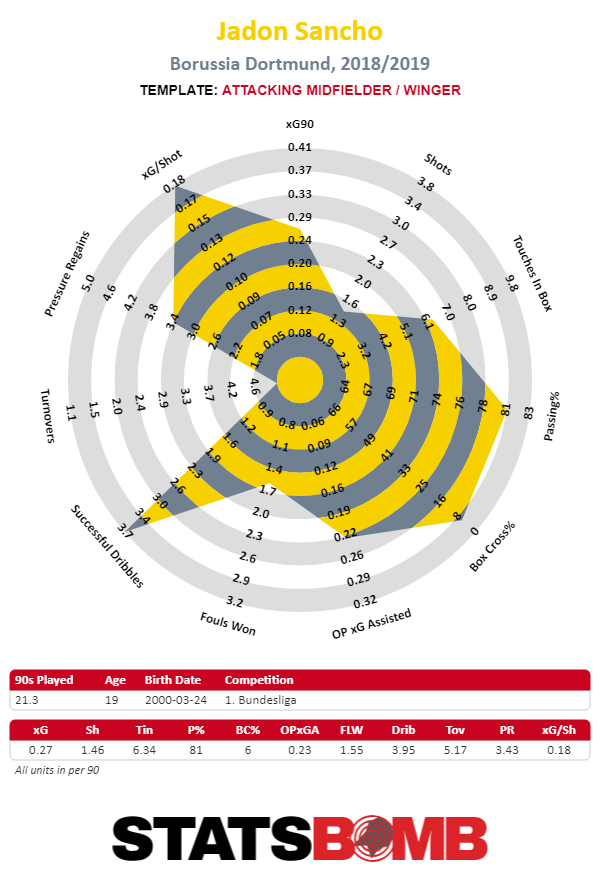
At 19, he might be the best teenage footballer in the world. His unique career path, from youth star at Manchester City, to plain old star at Borussia Dortmund might well have been concocted by a mad scientist to be the ultimate catnip to United. It is nearly impossible to find a young English star who is already established at the highest levels of the game. With an added bonus of sticking it to crosstown rivals throw in, how could United possibly say no?
And then there’s the positional need. Despite a squad that’s top heavy with attacking talent, United really don’t have a player whose best position is the right wing. Romelu Lukaku, Marcus Rashford, Anthony Martial, Jesse Lingard, Alexis Sanchez, and Juan Mata are all more comfortable playing through the middle or on the left. So, there’s real need. (Just how Manchester United have managed to spend so much money over the years and acquire so many attacking players without finding one who is comfortable on the right is another matter entirely).
The problem with acquiring Sancho isn’t that the move wouldn’t make sense. The problem is that there are a lot of other moves that would make more sense. That’s because, right now, Manchester United are already a very good attacking side. What they aren’t is a very good defensive one. Sancho might very well improve them, but a lot of other cheaper moves would improve them more, and improve them more quickly.
Nemanja Matic is Manchester United’s defensive midfielder. He’s 30. While he remains an assured passer and decent defender in tight spaces, his mobility is in steep decline and he simply can’t patrol the wide swaths of the pitch and attacking team needs him to. And it’s not like as he enters into his footballing golden years that’s going to improve. He’s paired with Ander Herrera. Herrera has finally found the form that brought him to United’s attention in the first place.
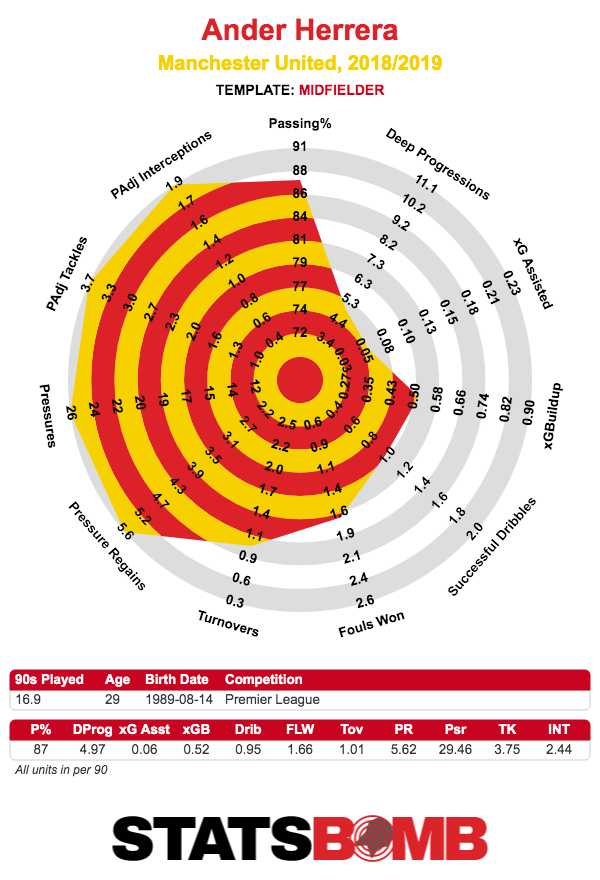
He’s also 29. He also reportedly may be on his way to Paris Saint-Germain this summer. So that’s basically an entire midfield that needs replacing. Even if, somehow, United talk themselves into Fred, Scott McTominay and Andreas Pereira all being ready to contribute in deep midfield roles next season, that still leaves extra minutes to be filled behind Paul Pogba. It’s hard to look at the state of that midfield and not see United needing one if not two major pieces and needing them much more urgently than they need Sancho.
Then there’s the defense. Luke Shaw’s resurgence at left back has at least temporarily settled one position.
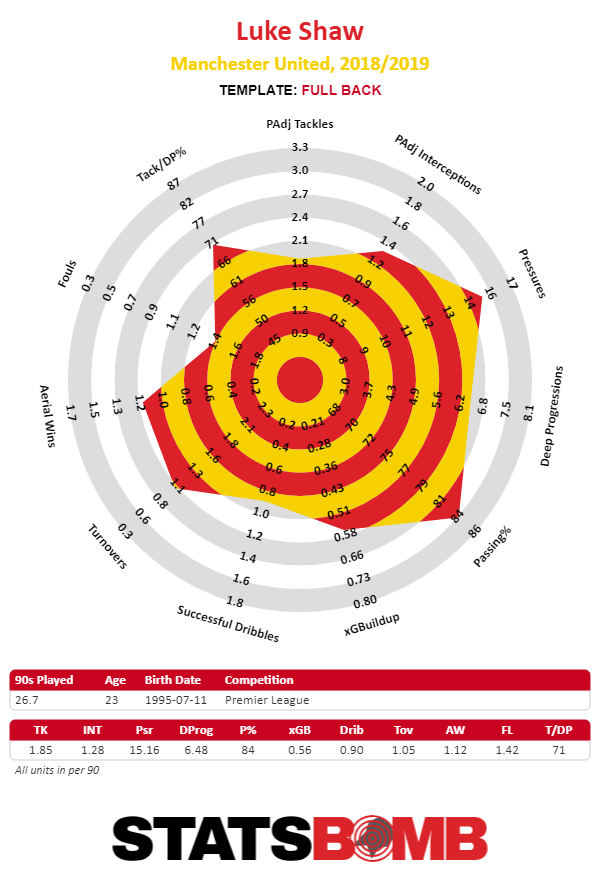
It has also freed up Ashley Young to play the majority of the minutes at right back. Young has performed admirably there. He’s also going to be 34 this summer. Young was preferred there to Antonio Valencia, who will be leaving at the end of the season and Matteo Darmian who is a person that still exists (and had the option year of his contract picked up by United). That leaves only Diogo Dalot. He’s 20, and maybe he’ll be good one day, but for now the 33-year-old winger who was converted to left back before being converted to right back is preferred to him. So, draw your own conclusions about how far along the developmental path he is.
The center back situation is a little more in the eye of the beholder. After Jose Mourinho’s departure, Chris Smalling and Victor Lindelof have settled into a clear partnership. They are…fine. It’s possible if they had a stronger defensive unit around them they might even be good. Having a couple of center backs who are good enough to get the job done under the right circumstances isn’t a problem, if you give them the right circumstances. The optimistic case for United’s defense is that if they improve at midfield and right back then the center backs will be able to perform at a top level. Alternatively, they might just need a top line central defender as well as their other upgrades.
None of this is new. The names might have changed but the story remains the same. United needed to beef up defensively when they went out and acquired Sanchez last season, a year after acquiring Henrikh Mkhitaryan, a year after acquiring Anthony Martial and Memphis Depay, a year after acquiring Angel Di Maria, a year after acquiring Juan Mata. At some point the continued attacking merry-go-round needs to give way to a defensive focus or the results will just keep being the same.
None of this is to say that acquiring Sancho is a bad move, only that it’s one that doesn’t solve the core problems that this United team has struggled to solve since Alex Ferguson left. The team needs strength in midfield and better defenders. If they add the right players at those positions in addition to adding Sancho, then this summer will be a huge success. If they miss out on Sancho, but bulk up elsewhere then it’s still likely this team will improve, perhaps dramatically. But, if all that United does is sign Sancho, and not give the rest of the squad the full tune-up it needs, well then it’s likely the summer will be a failure even if Sancho himself is a huge success. United need an overhaul, irrespective of whether they land an attacking superstar. Without it, Sancho will just be another shiny coat of paint.
Header image courtesy of the Press Association
